The Louvre is the largest art museum in the world and one of the top attractions in Paris. Planning a visit to the Louvre may sound complicated. With its massive size, long list of art exhibits, and tales of long lines, you may be wondering how to visit the Louvre and actually enjoy your visit.
We have visited the Louvre three times in recent years. From our multiple experiences, we created this guide to help you have the best experience at the Louvre.
In this guide, we will be your virtual tour guide, navigating you through the Louvre’s maze of rooms to its most important masterpieces. We cover the best way to visit the Louvre, including the top things to see, where to go to see the most famous works of art, the best time of day to plan your visit, and whether or not it is worth it to take a tour.
Tim and I also came up with a walking route through the Louvre that quickly and efficiently takes you to the must-see sights. On this Louvre treasure hunt, you’ll get to see famous sculptures carved by Michelangelo, ancient artifacts from Egypt and Mesopotamia, paintings by famous artists, and of course, the Mona Lisa.
Let’s get started.
Interesting Facts about the Louvre
The Louvre is the largest art museum in the world. In 2023, it was the world’s most visited museum (with the Vatican Museums taking the #2 spot), with 8.9 million visitors. It’s also one of the most popular tourist attractions to visit in Europe.
With that being said, the Louvre draws enormous crowds. Many people come here for a glimpse of Da Vinci’s Mona Lisa, but several other art pieces, such as Venus de Milo and the Winged Victory of Samothrace, are also extremely popular.
Long before the Louvre became an art museum, it was a fortification. The remnants of these fortifications, which date back to the 12th century, can be seen in the Medieval Louvre, in the crypt below the rooms of the museum. The Medieval Louvre is one of the sights on our walking tour.
In the 14th century, Charles V converted the fortifications into his residence. In 1546, Francis I began to design the residence in a Renaissance style and over the next 100+ years, other French monarchs added wings and rooms onto the Louvre. The expansion of the Louvre took a pause in the 1670’s when Louis XIV redirected his budget to the Palace of Versailles.
The Louvre became a public museum on August 10, 1793, during the French Revolution. At the time, just over 500 works of art were on display.
Since the 18th century, the Louvre has undergone several more renovations and thousands of works of art added to its collection.
The Louvre contains over 600,000 works of art, of which roughly 35,000 are on display. These works of art span almost 10,000 years. The exhibition area inside of the Louvre is an incredible 73,000 square meters (783,000 square feet). It would take weeks to see every piece of art on display.
In 1988, the glass pyramid designed by I. M. Pei was added to the Louvre. This is now the main entrance into the museum.
So, a visit to the Louvre is more than just gazing at a few famous works of art. It also has a long, rich historical background and was once the palace of French Kings.
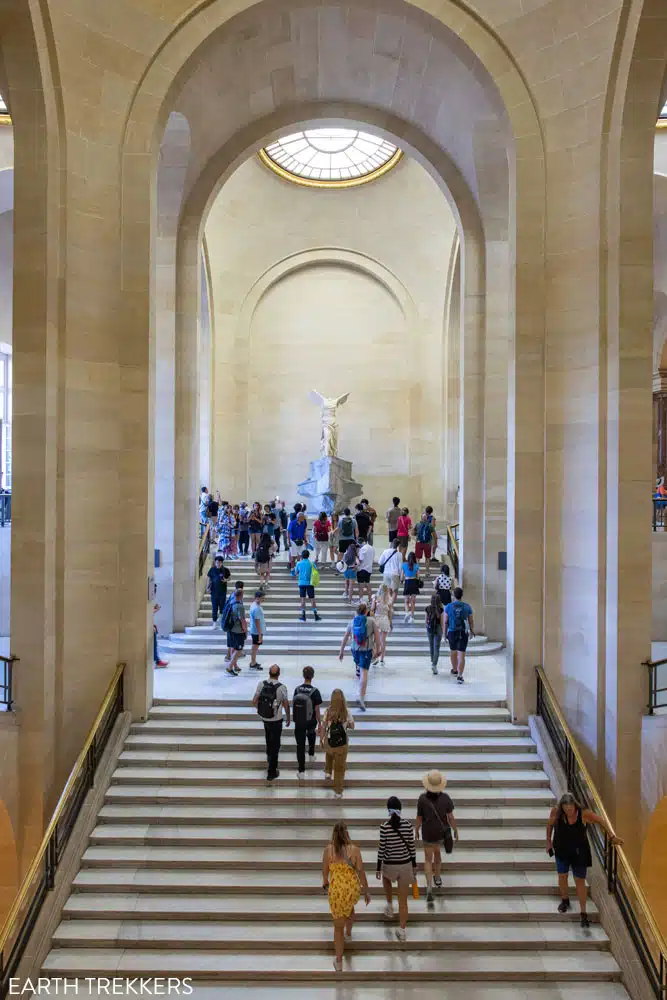
The Victory of Samothrace
Quick Facts about the Louvre
Here are a few essential things to know when planning your visit to the Louvre.
OPENING HOURS: 9 am to 6 pm Monday, Thursday, Saturday and Sunday; 9 am to 9 pm on Wednesday and Friday; CLOSED ON TUESDAY; last entry one hour before closing; confirm these hours before you go, because they change frequently
CLOSED: January 1, May 1, December 25
COST: €22 online
FREE ADMISSION: First Friday of the month after 6 pm, with the exception of July and August. Free admission for people under 18 and those 18 to 25 years old who are residents of the European Economic Area.
ROOM CLOSURES: All rooms are not open every day of the week. For example, Napoleon’s Apartments are not open every day of the week. Before your visit, check the official website for room closures on the day you plan to visit, to see if you need to adjust your plans or visit on a different day.
METRO: Palais Royal – Musee du Louvre (lines 1 and 7) and Pyramides (line 14)
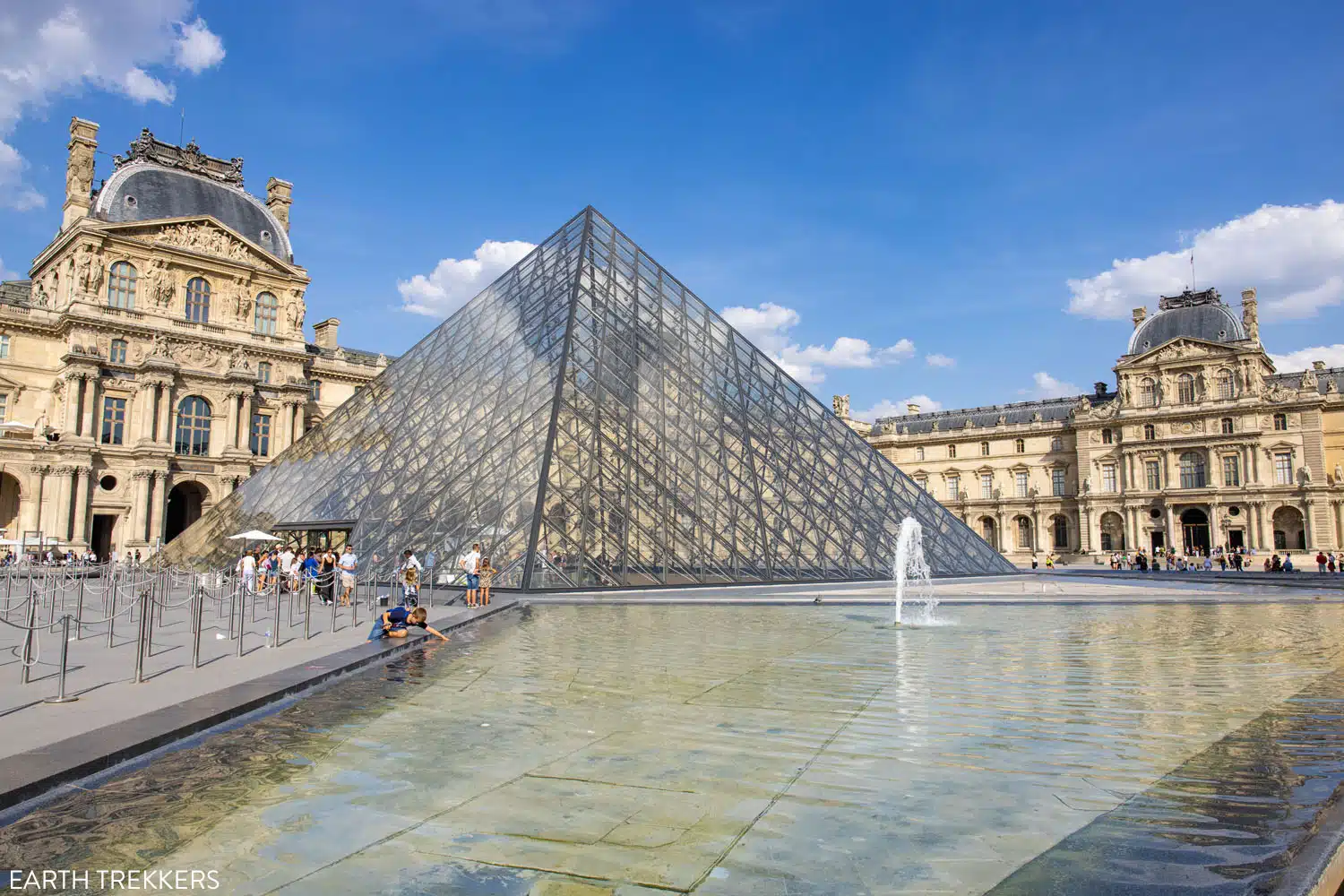
How to Skip the Ticket Line at the Louvre
The first important thing to know is how to ‘skip the line’ at the Louvre. Waiting an hour in the hot sun to purchase tickets for the Louvre is probably not how you plan to spend your precious time in Paris.
WHAT DOES ‘SKIP-THE-LINE’ MEAN? A skip-the-line ticket is a pre-purchased ticket that allows you to skip the ticket line. You will still have to wait in a security line to enter the Louvre, and this can take a few minutes to up to 30 minutes, according to the official website.
If you do not have a ticket in advance, you will have to wait in the ticket line. Off season, this wait could be just a few minutes. In July or August, this wait can range from 1 to 3 hours, depending on the time of day.
#1 Purchase Your Ticket Online in Advance
Before your visit to Paris, visit the official website to purchase your ticket in advance. These tickets cost €22.
It’s best to do this as far in advance as possible. If your visit is during peak season (July, August, and holidays), book your tickets at least one month in advance.
If tickets are sold out on the official website, you can purchase them on GetYourGuide.
For the best experience in the Louvre, book the first time slot of the day.
PRO TRAVEL TIP: There are a limited number of tickets sold onsite per day. These can sell out before the day is over, so if you do not purchase a ticket in advance, you risk onsite tickets selling out before you arrive at the Louvre. This is another good reason why you should purchase your ticket online in advance.
#2 Use a Museum Pass
The Louvre is included on the Museum Pass. However, you must book your time slot in advance, which you will do on the official website.
#3 Take a Tour
There are guided tours of the Louvre that includes your ticket to skip the line. This 2-hour small group tour gets rave reviews.
Entrances into the Louvre
There is more than one entrance into the Louvre. The entrance you use depends on whether or not you have a ticket and your ticket/tour type.
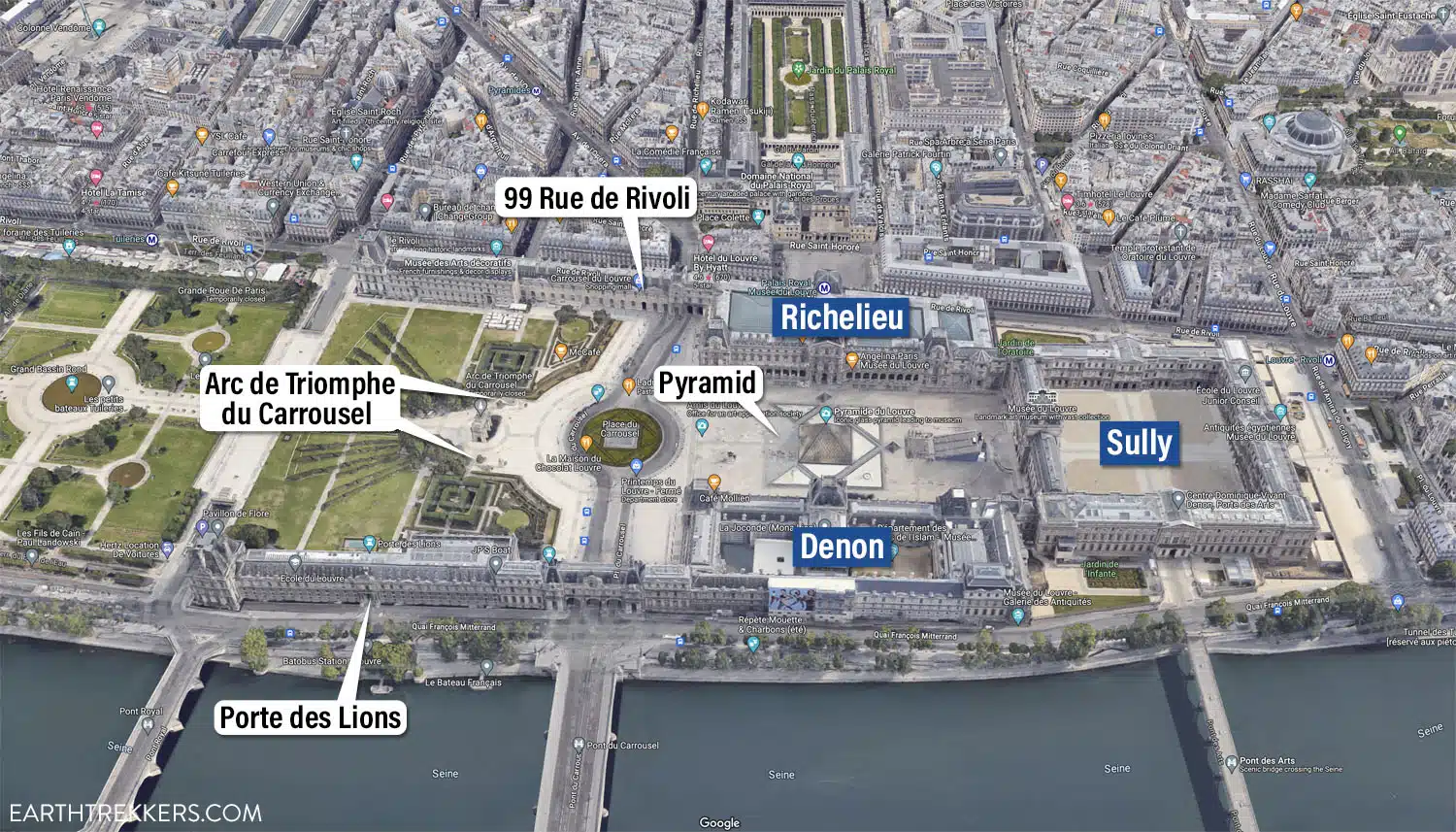
Map of the Louvre entrances (in black and white) and the three wings of the Louvre museum (in blue and white). Map adapted from Google.
The Pyramid
The Pyramid is the main entrance into the Louvre. At the Pyramid, there are four different lines:
Orange Line: Visitors without tickets
Green Line: Visitors with a ticket or the Paris Museum Pass
Blue Line: Priority Access for disabled visitors and staff members
Yellow Line: Visitors with Membership Cards
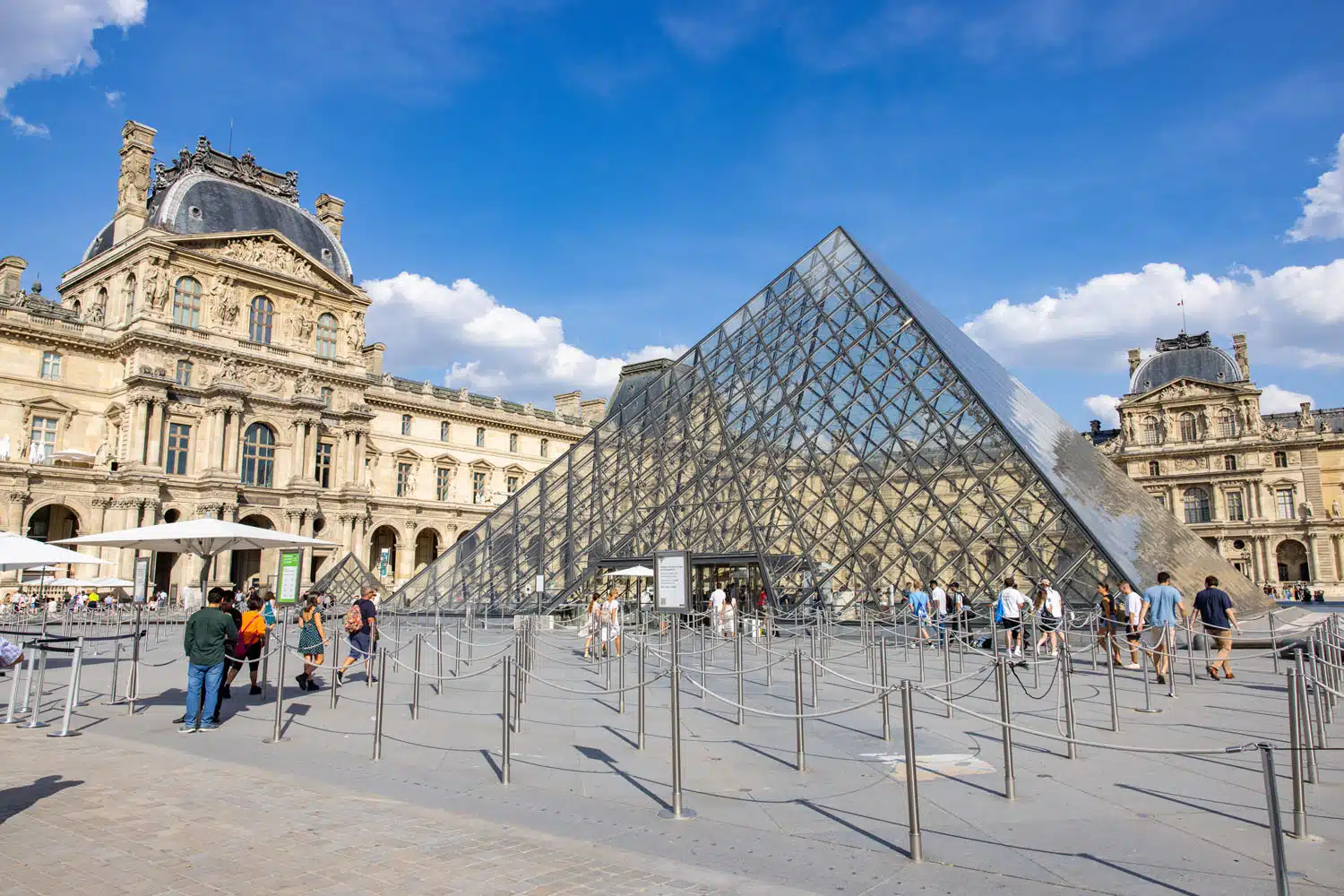
The Pyramid entrance
At this entrance, you will line up in the appropriate line, just outside of the Pyramid. A staff member will check if you have a ticket if you are in the green line.
Once you enter the Pyramid, you will go through airport style security and then descend into the Louvre on an escalator or steps. From this lower level, you will choose to enter the museum at either the Sully Wing, Denon Wing, or Richelieu Wing (more on this later). Your ticket will be scanned at one of these three entrances.
On our most recent visit, we entered at the Pyramid, following the instructions on our Louvre ticket. We had a 9 am entry slot. We got in line at 8:40 am and had a 5-minute wait to enter the Louvre once it opened. Our visit was September 7, 2023.
PRO TRAVEL TIP: If you do not have a ticket into the Louvre, the only entrance you can use is the Pyramid entrance. We did not see a ticket office at the Galerie du Carrousel entrance and were told by a staff member that tickets are not for sale at the Porte des Lions entrance.
Galerie du Carrousel
You can also enter the Louvre from an underground shopping mall, called the Galerie du Carrousel. This small underground mall is located underneath the inverted pyramid at Place du Carrousel and there are several ways to get here.
#1. At 99 Rue de Rivoli, take the escalator down to Galerie du Carrousel.
#2. On either side of the Arc de Triomphe du Carrousel are steps leading underground into the Galerie du Carrousel.
#3. From the Palais Royal – Musee du Louvre metro station, follow signs to Galerie du Carrousel to stay underground and walk to the Louvre entrance.
All of these entrances take you underground to the inverted pyramid and an entrance into the Louvre.
Once you reach the inverted pyramid, you can enter the Louvre through the airport style security line and it is a 5-minute walk to the main floor of the museum, the room below the pyramid. You must have a ticket as there is no ticket window at the Galerie du Carrousel entrance into the Louvre.
PRO TRAVEL TIP: When you exit the Louvre, the only exit is through Galerie du Carrousel. In my opinion, the Pyramid is most interesting way to enter the Louvre, since seeing the Pyramid with the museum buildings in the background is one of Paris’ most iconic views. If you enter via Galerie du Carrousel, you will miss this view, unless you walk to pyramid after touring the museum.
Porte des Lions
The Porte des Lions entrance is located on Quai Francois Mitterand. It is closed on Friday. This entrance is reserved for visitors who have a ticket. Since this entrance is located far from the Pyramid, it has a much shorter line.
Richelieu Passage
This entrance is reserved for groups and visitors with membership cards.
The Layout of the Louvre
Now that made it inside, where do you go?
PRO TRAVEL TIP: You can download a copy of the Louvre map from the official website. The Louvre also has an interactive map, which is useful for planning out what you want to see ahead of time. We used these to navigate through the Louvre, using our smartphones.
Reception Hall
Once you enter the Louvre from the Pyramid or Galerie du Carrousel, you will be standing on the main floor, just under the Pyramid. From this floor, there are three entrances, one to each wing of the Louvre: Denon, Sully, and Richelieu. You will pick one of these entrances, depending on what you plan to see first, and it is at one of these entrances where your ticket will be scanned.
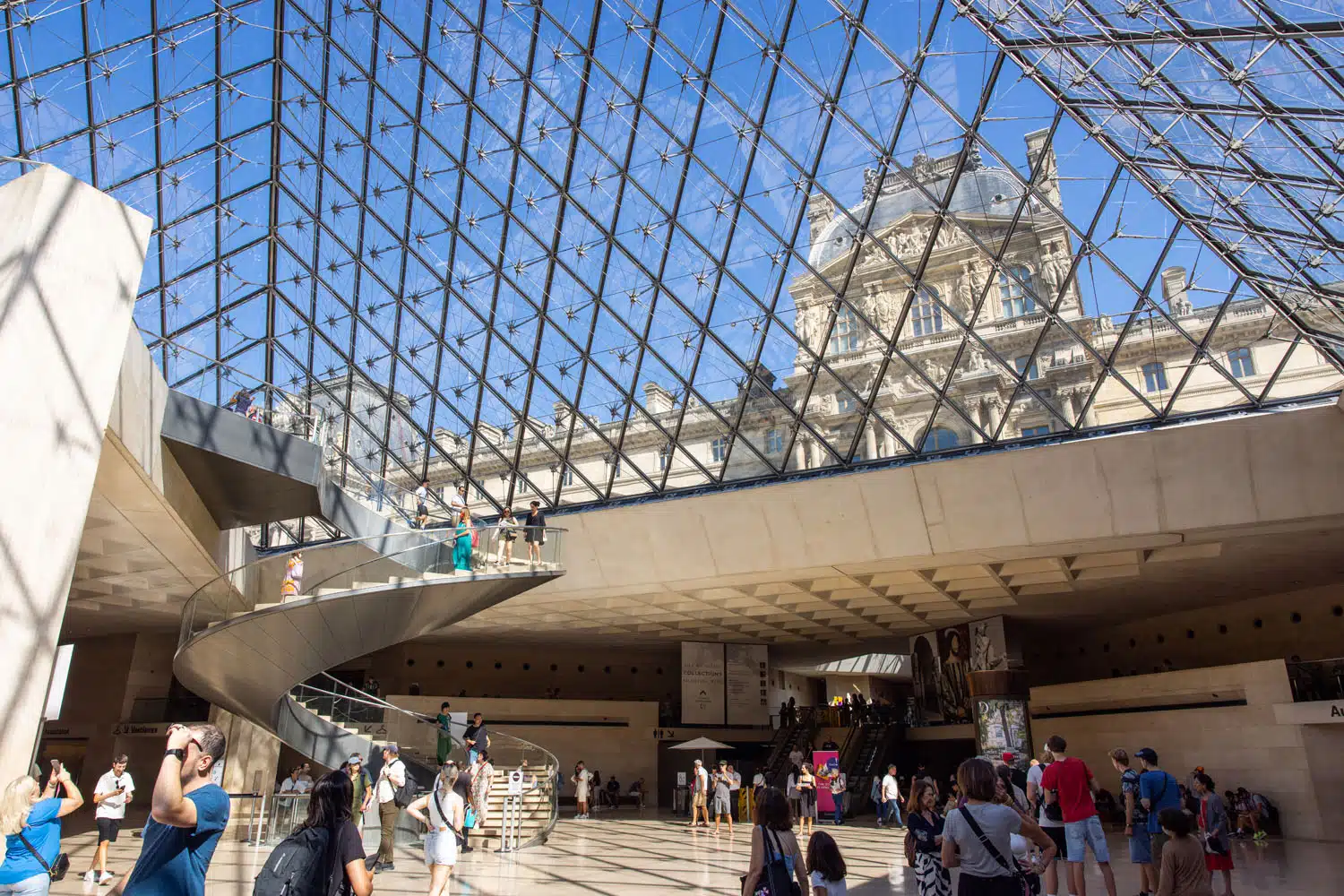
The main floor (reception hall) of the Louvre
Denon Wing
If you only have time for one wing in the Louvre, this is the one we recommend. The Denon Wing contains many of the top sights in the Louvre, including the Mona Lisa, the Winged Victory of Samothrace, French and Italian paintings, the Apollo Gallery, and Roman and Greek Antiquities.
Sully Wing
The Sully Wing contains the oldest artifacts in the Louvre. It is here that you can walk through the Medieval Louvre, see Egyptian antiquities dating back to 4,000 BC, near Eastern antiquities from 7,000 BC, and see Venus de Milo.
Richelieu Wing
In the Richelieu Wing, tour Napoleon III’s apartments, see paintings from Northern Europe, see antiquities from Iran and Mesopotamia, including the Code of Hammurabi, and take a break at Angelina’s for coffee, hot chocolate, and pastries.
Best Time to Visit the Louvre
The best time of the day to visit the Louvre is first thing in the morning, two to three hours before closing, and on Friday nights, when the Louvre does not close until 9:45 pm.
The Louvre is closed on Tuesdays. Monday and Wednesday can be busy, since these fall before and after the Tuesday closure. Weekends and holidays can also be very busy. Thursday tends to be the least crowded day of the week.
Best Things to See in the Louvre
With over 35,000 works of art on display, spread out across the largest museum in the world, how do you narrow down what to see?
Before our most recent visit to the Louvre, we spent a lot of time researching the top art pieces and historical artifacts in the Louvre. We came up with a list of 20 things to see in the Louvre. This list is perfect for those who want to see the highlights of the Louvre, located throughout its wings and multiple floors, without spending all day in the Louvre.
Below is a list of the top things to see in the Louvre and their location. All of these are included in our walking tour below.
- Mona Lisa – Room 711 – Denon Wing
- Venus de Milo – Room 346 – Sully Wing
- Winged Victory of Samothrace – Room 703 – Denon Wing
- The Grande Galerie – Room 710 – Denon Wing
- Apollo Galerie – Room 705 – Denon Wing
- Wedding Feast of Cana – Room 711 – Denon Wing
- The Caryatids – Room 348 – Sully wing
- The Raft of Medusa – Room 700 – Denon Wing
- The Rebellious Slave and the Dying Slave by Michelangelo – Room 403 – Denon Wing
- Psyche Revived by Cupid’s Kiss – Room 403 – Denon Wing
- Sleeping Hermaphrodite – Room 348 – Sully Wing
- Liberty Leading the People – Room 702 – Denon Wing
- The Consecration of the Emperor Napoleon – Room 702 – Denon Wing
- Medieval Louvre – lower level of the Sully Wing
- The Great Sphinx of Tanis – Room 338 – Sully Wing
- Egyptian Antiquities – Multiple rooms in the Sully Wing
- The Code of Hammurabi – Room 227 – Richelieu Wing
- Lamassus of Khorsabad Palace – Room 229 – Richelieu Wing
- Napoleon III’s Apartments – Level 1 – Richelieu Wing
- The Cour Puget – Room 105 – Richelieu Wing
Walking Tour of the Louvre
Tim and I came up with a walking tour that takes you to the highlights of the Louvre, quickly and efficiently. Think of it as a treasure hunt through the Louvre.
If you want to visit the Louvre the cheapest way possible, and have guidance on the best things to see, this is how to do it. Purchase your ticket online in advance and we’ll take you through the Louvre, without needing to pay extra for a guide.
About this Louvre Walking Tour
Our walking tour starts with the most famous art pieces in the Louvre, so if you prefer a quick visit to the Louvre, just do Part 1 of our tour. For those who want to go deeper into the Louvre, follow our walking tour to the very end.
This walking tour can be done any time of the day, but it works best first thing in the morning. With a 9 am entry and our walking route, you get to see a few art pieces and tour a few remarkable rooms before they are filled with people. So, for the best experience, book your Louvre tickets in advance for a 9 am time slot. To get in front of the crowds, arrive a little early (we got in line at 8:40 am).
PRO TRAVEL TIP: The official Louvre website also has several walking tours through the Louvre, depending on your interests and available time. I also recommend checking which rooms will be open on the day of your visit, because there could be some closures. On the day we did this, Napoleon III’s apartments and the North European paintings were closed.
Louvre Walking Tour
If you follow the entire walking tour, it will take between 3 hours and 5 hours. To do it in 3 hours, you have to start at 9 am, when crowds are very light, and move very fast. Most people will do this in 4 to 5 hours.
This tour starts with the essential artworks and then goes deeper into the Louvre. Since it is a half day tour, you still are only visiting the highlights. You can further extend this tour, by spending more time in various rooms and taking detours along the way.
We provide detailed walking directions, but it also helps to download a map of the Louvre on your phone before your visit.
You can also access an interactive map on the official website that is very useful for identifying room numbers and locations of artworks.
Get a Digital Download of this Louvre Walking Tour
Do you want a printer friendly version of this walking tour? How about an eBook version that can be downloaded onto your computer or mobile device?
Our Louvre Walking Tour eBook is a self-guided walking tour of the Louvre that will take you to the museum’s most important masterpieces. This guide covers how to purchase tickets, the different entrances, helps you navigate through the Louvre’s maze of rooms, and provides helpful tips for having the best experience. It is a 15-page document that you can download to take with you or print at home.
Click here to purchase the eBook on Etsy.com.
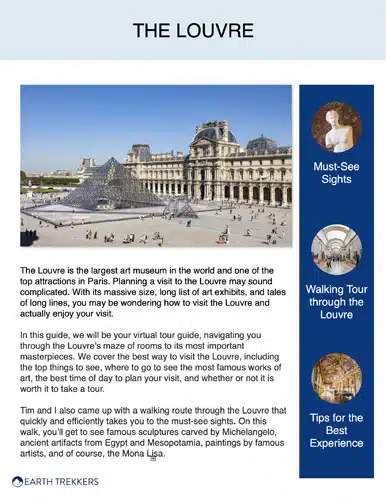
Part 1: Must-See Sights in the Louvre
Time: 1 to 1.5 hours
For those who just want to visit a few key pieces of art, follow Part 1 of our walking tour. Things you will see include:
- The Caryatids
- Venus de Milo
- Winged Victory of Samothrace
- Grande Galerie
- Mona Lisa
- Apollo Gallery
The Caryatids
From the main reception floor (the large room under the pyramid), take the escalator/steps up to the Sully Wing. This entrance is the middle of the three entrances into the wings of the Louvre. It looks like this (look for the word “Expositions”):
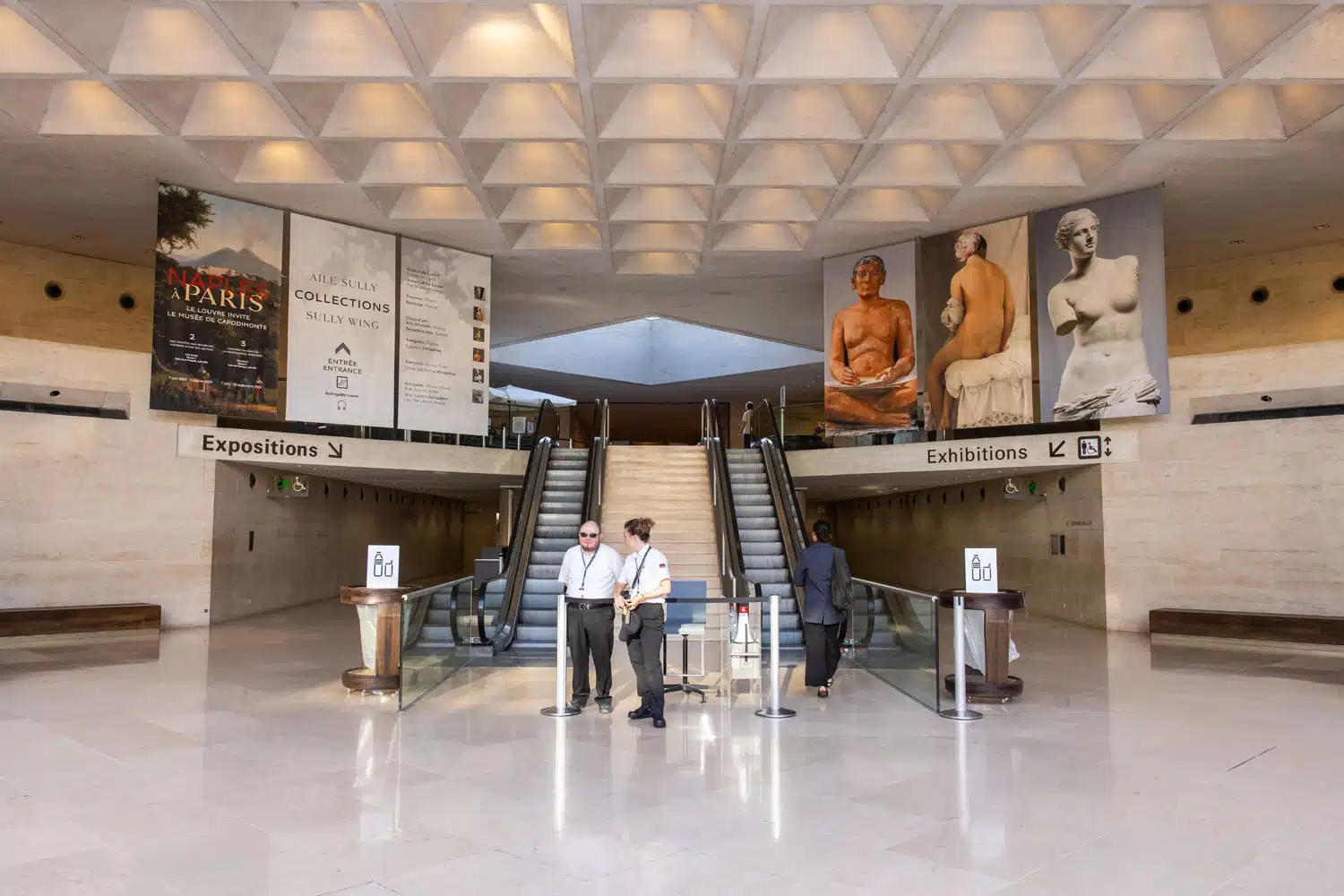
If you are doing this walking tour at opening time, you’ll see 95% of people heading directly to the Denon Wing with the goal of seeing the Mona Lisa first. I know it’s tempting, but she’ll still be there in about fifteen minutes. Crowds take a while to gather around her, so there is no rush to get to the Mona Lisa right away. By following our route, you get to see a few amazing rooms and possibly have them all to yourself (we did).
After you show your ticket, walk straight down the long hallway. Once you reach the entrance to the Pavilion de l’Horloge, take the stairs up to level 1 (this is a series of several staircases; follow signs for 1et etage, Antiquities grecques et romaines). At the top of these stairs, turn right into the double wooden doors.
You are now standing in room 348 of the Sully Wing, the Salle des Cariatides. Turn around to see the Caryatids, which are four female sculptures that serve as columns and support the musician’s gallery. These were created in 1550 by Jean Goujon. They were inspired by the Caryatids on the Erechtheion on the Acropolis in Athens.
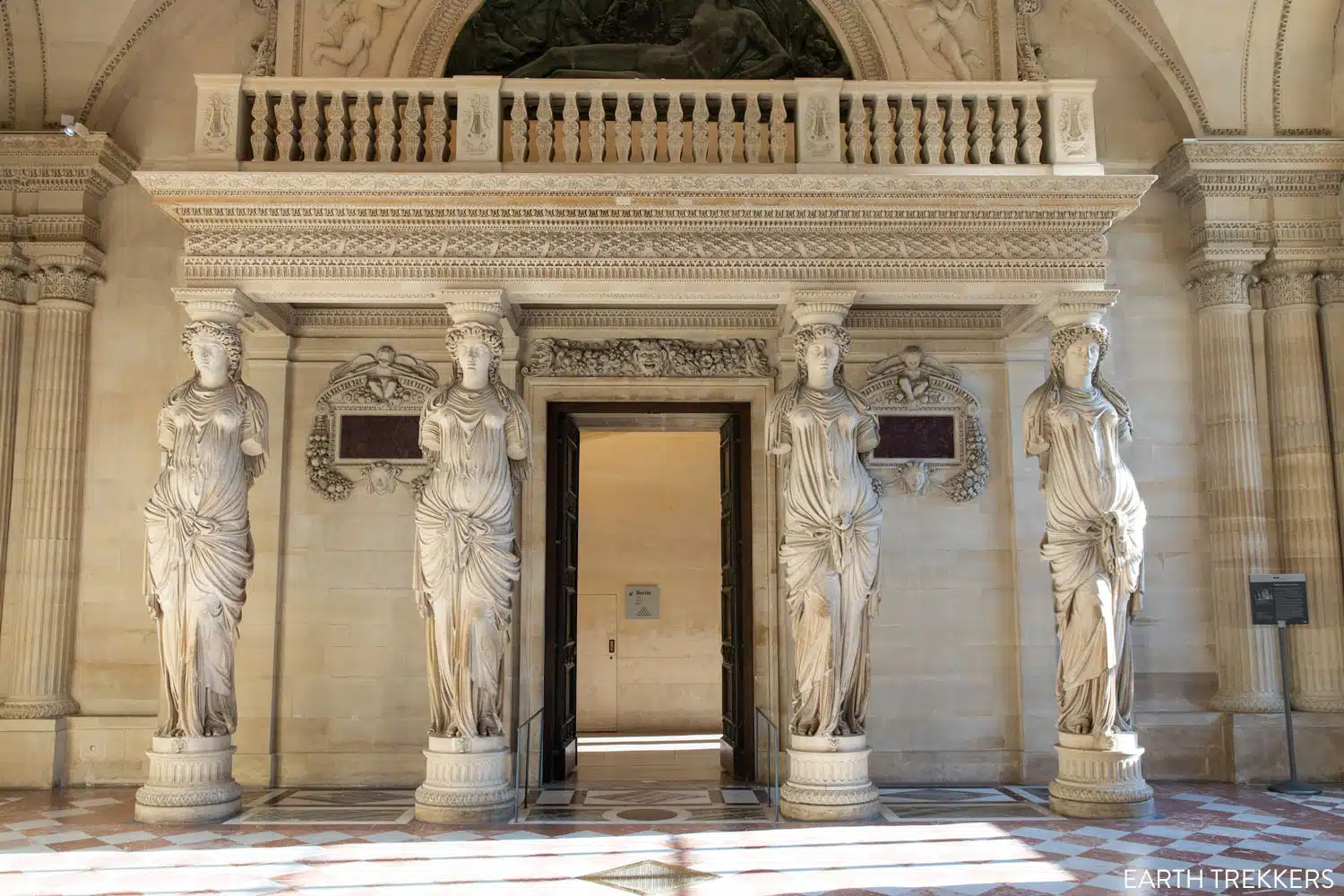
The Caryatids
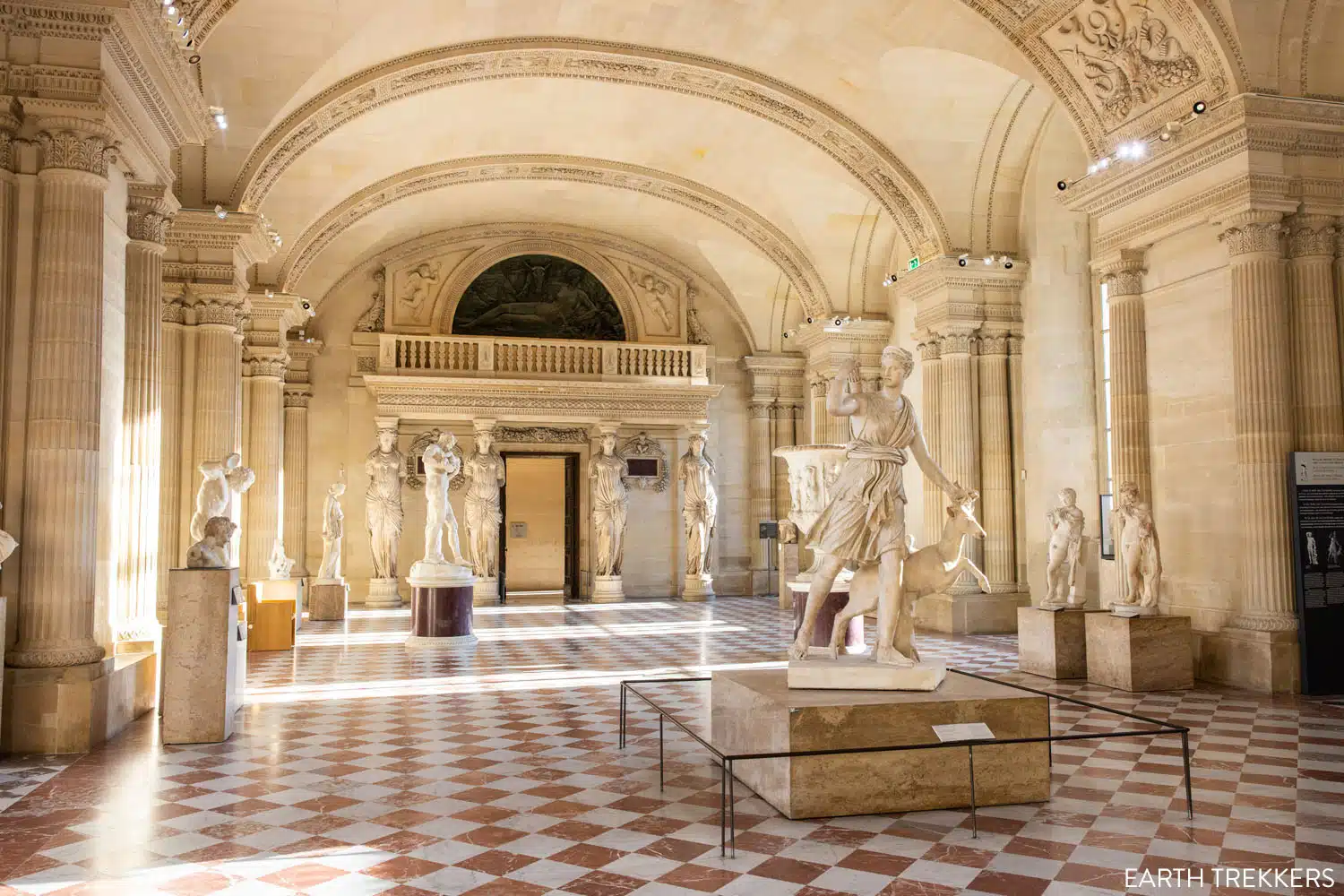
Salle des Cariatides
Walk through the room to the far end. In the corner to the left is Sleeping Hermaphrodite. This ancient Roman sculpture was discovered in the Baths of Diocletian. Gian Lorenzo Bernini sculpted the mattress. The sculpture was first on display in the Borghese Gallery in Rome and later moved to the Louvre when it was sold to the French.
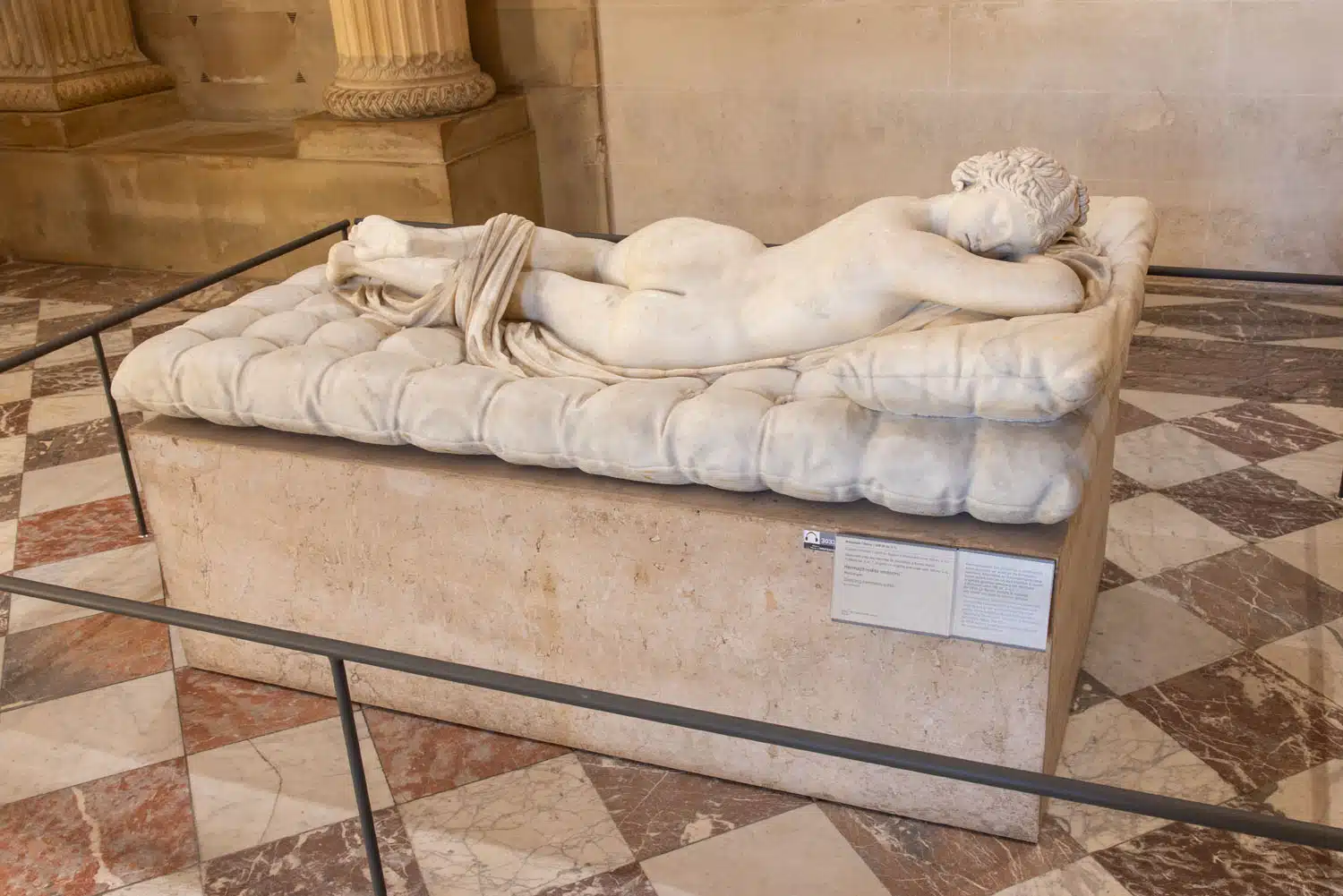
Sleeping Hermaphrodite
Venus de Milo
Walk around the right side of the fireplace and exit the room. Walk between the red pillars for a view of Venus de Milo.
This famous ancient Greek sculpture was carved during the Hellenistic period. It depicts Aphrodite, the Greek goddess of love. It was discovered on the island of Milos, Greece, in 1820, bought by Louis XVIII, and installed in the Louvre.
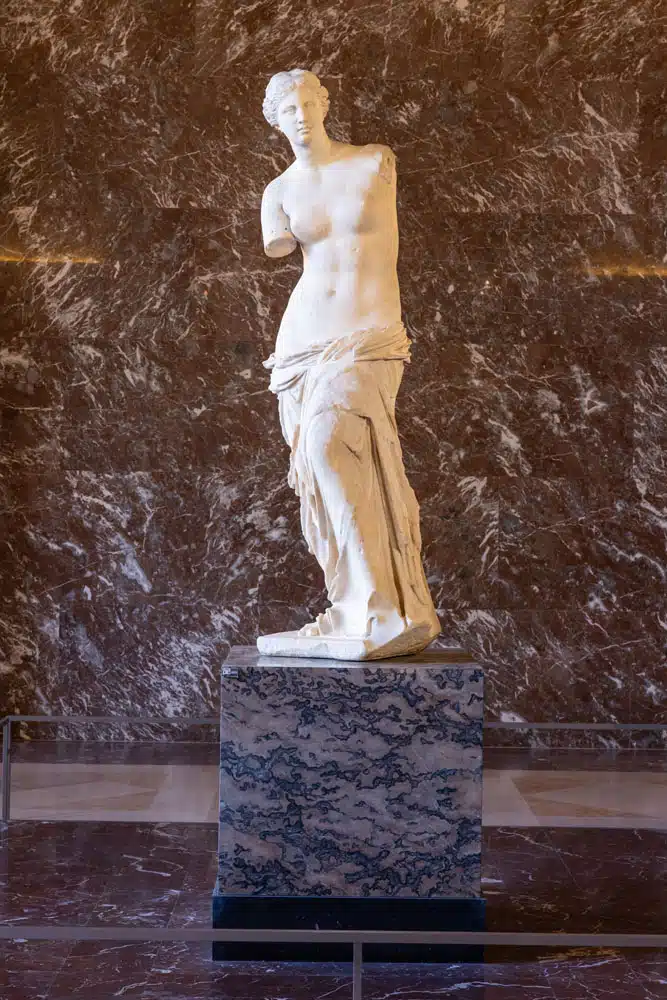
Venus de Milo
The Winged Victory of Samothrace
Turn around and walk through the red pillars. Turn left just past the red pillars, walk straight through the rotunda, and walk up the stairs. In front of you is the Winged Victory of Samothrace.
Like Venus de Milo, the Winged Victory of Samothrace is another Greek sculpture from the Hellenstic period. This statue represents the goddess Nike standing on a ship’s bow.
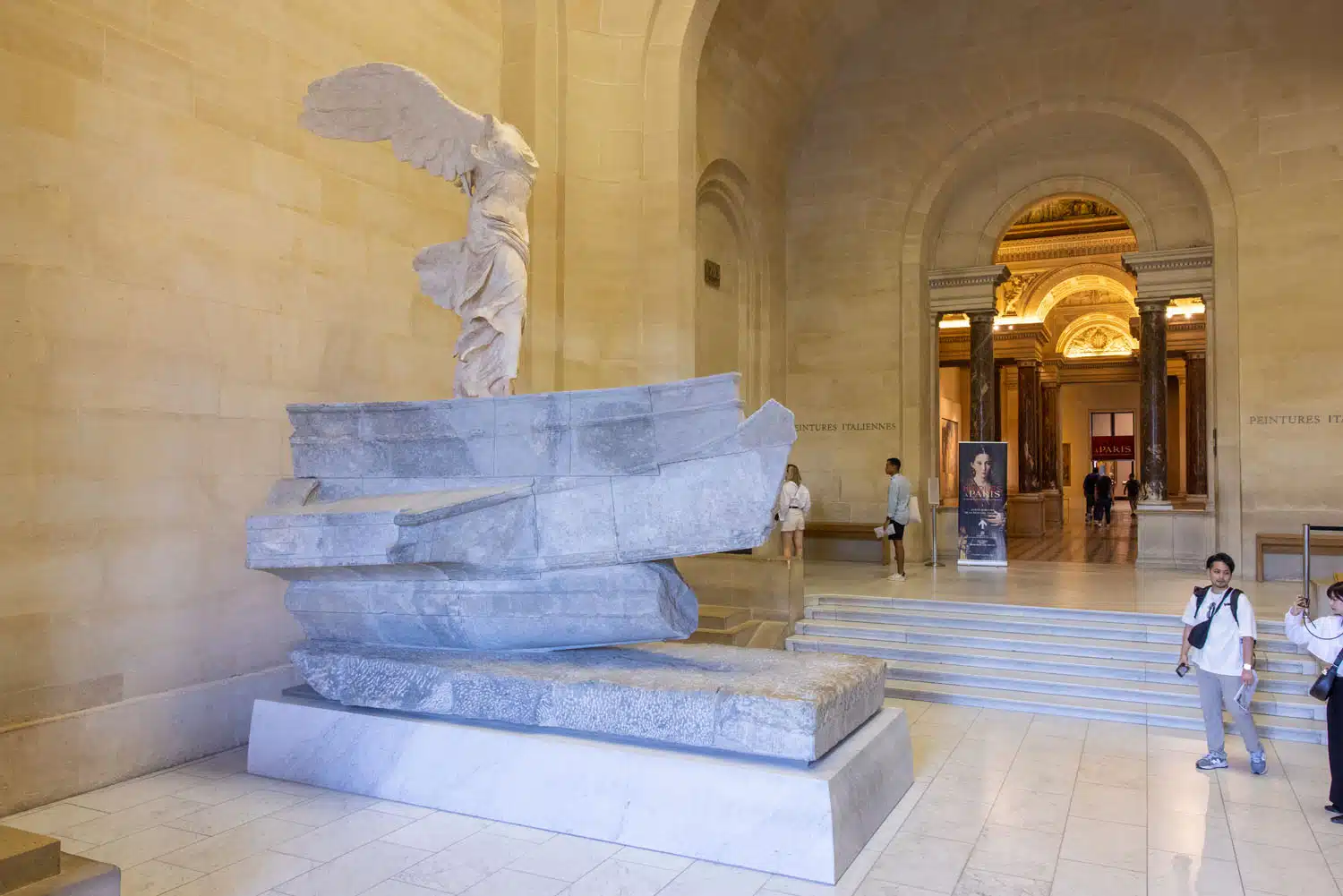
Winged Victory of Samothrace | How to visit the Louvre
Apollo Gallery (The Galerie d’Apollon)
Facing the front of Winged Victory, turn left and walk up a few more stairs and enter a round room (room 704). As a bonus, take a look out of the window for a beautiful view outside of the Pyramid.
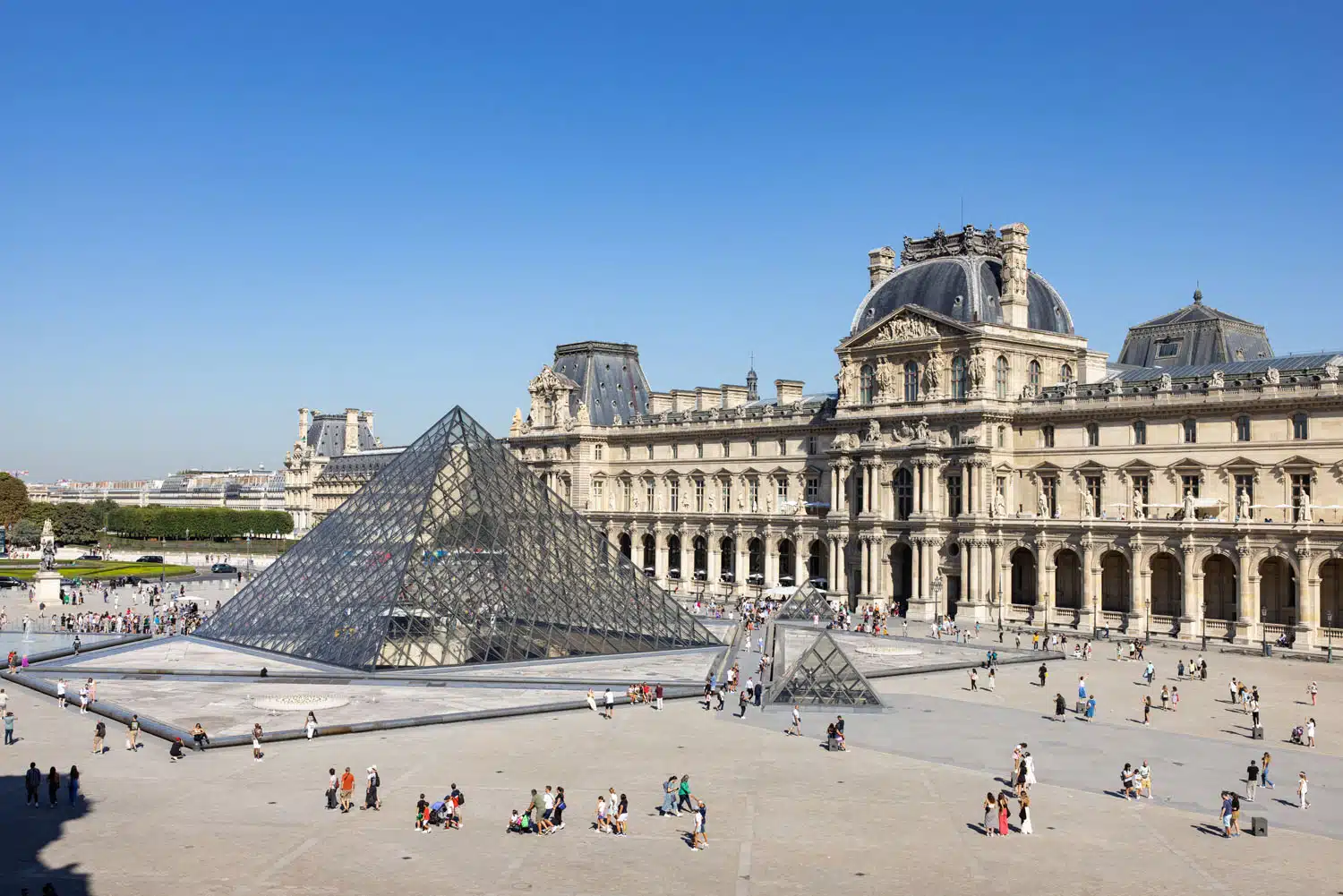
Then, enter the Apollo Gallery (room 705, Denon Wing). To be in this ornate room with little to no people is an underrated experience in the Louvre. We’ve also been here with a huge crowd and it is a much different experience.
The Apollo Gallery is decorated with paintings, stuccos, and tapestries. This part of the Louvre was rebuilt by Louis XIV after a fire burned the Petite Galerie. In the center of the room are display cases containing gems and some of the Crown Diamonds.
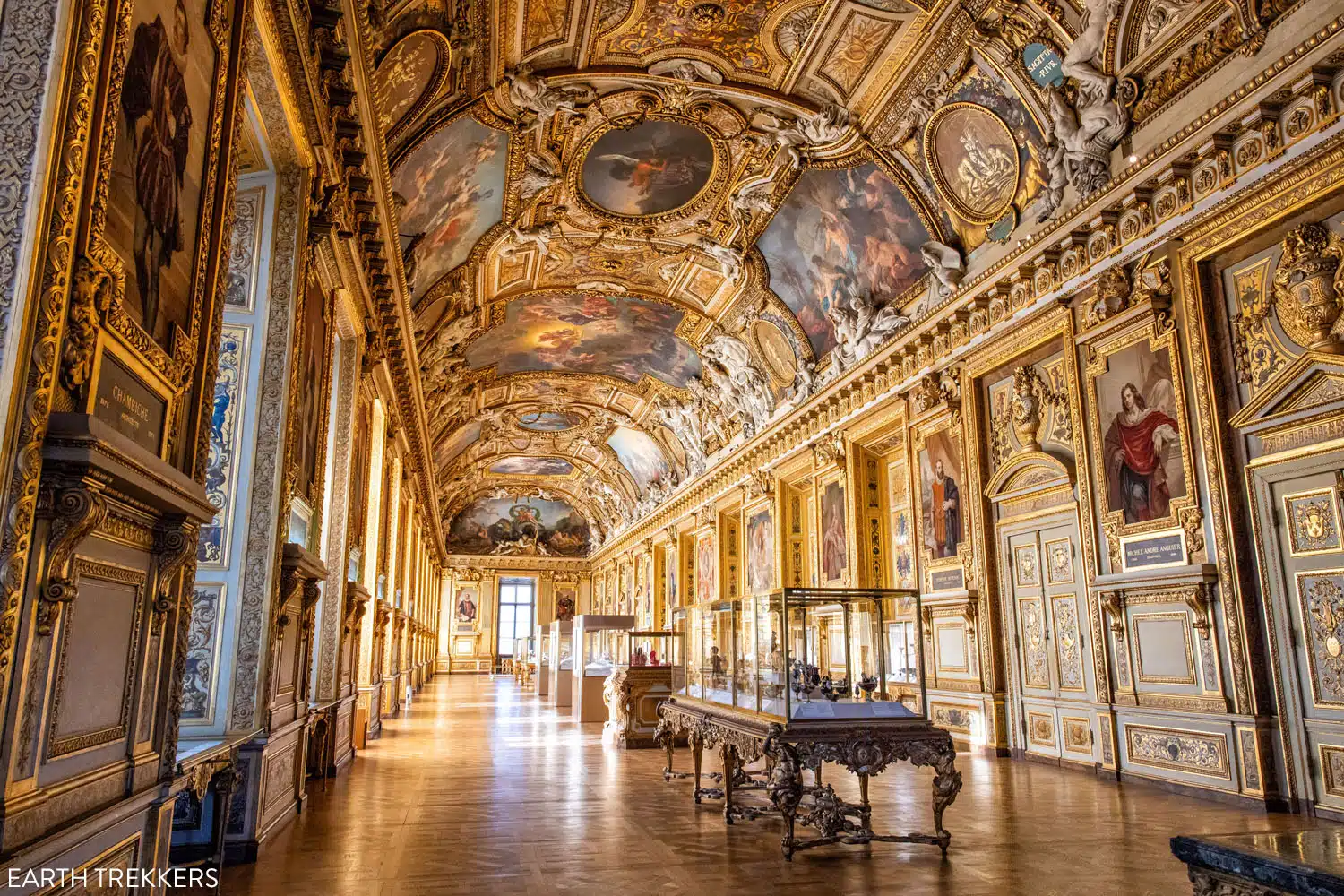
Apollo Gallery
The Grande Galerie
Walk to the far end of Apollo Gallery turn right to enter the Salon Carré (room 708). Look up at the ceiling and then continue straight into a long hallway. This is the Grande Galerie.
Adorning the walls is a large collection of paintings, some of them by Da Vinci and other famous Italian Renaissance artists. In the interest of time, we did not spend a lot of time here, but one of the most famous paintings in this room is Saint Anne, the Virgin and the Infant Jesus Playing with a Lamb by Leonardo Da Vinci.
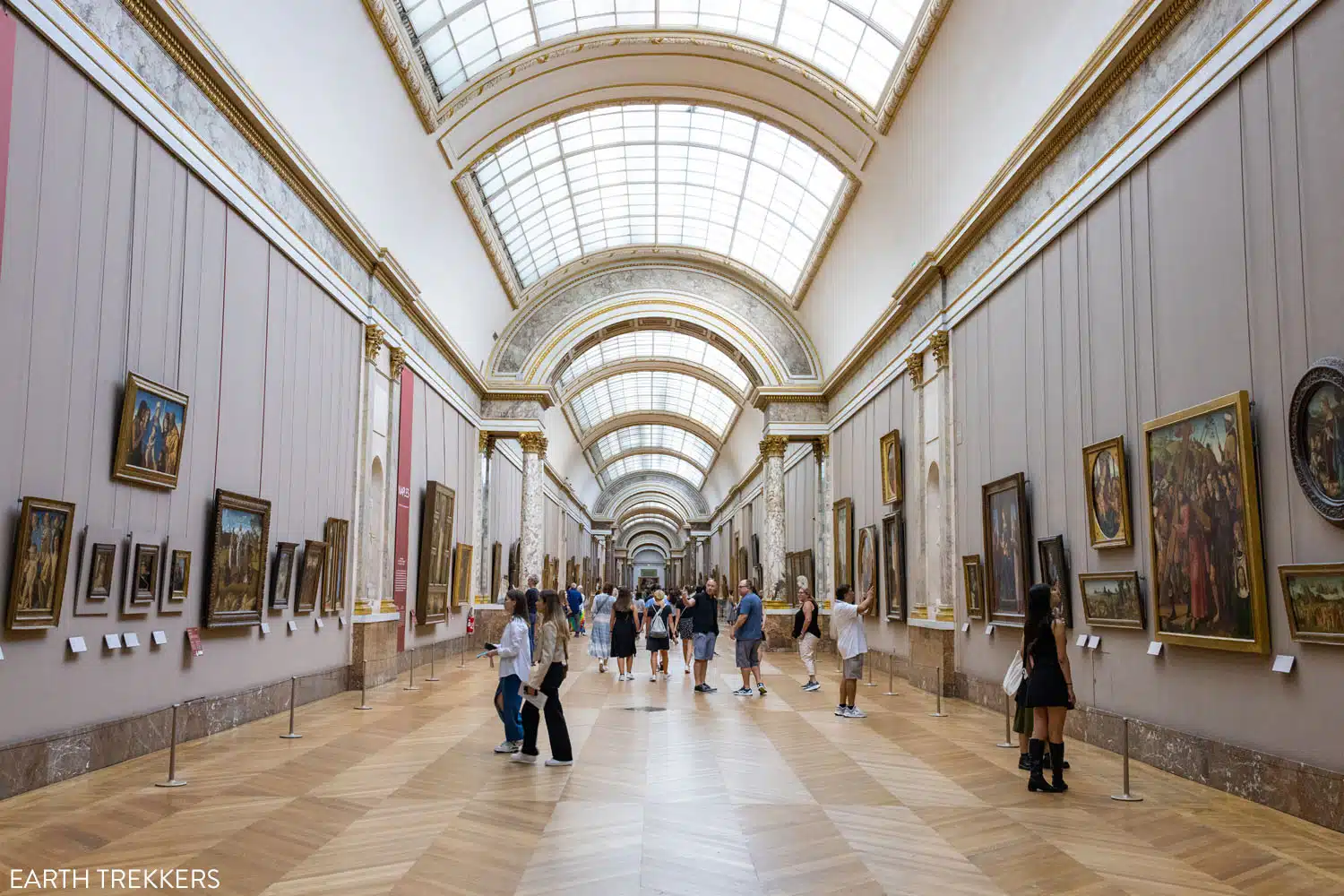
Grande Galerie | How to visit the Louvre
Mona Lisa
You have seen quite a few works of art in a short period of time. By this point, you are about 15 to 20 minutes into this tour, a little longer or shorter, depending on how long you linger at each artwork.
Now it is time to see the Louvre’s most famous masterpiece, the Mona Lisa.
Continue walking through the Grande Galerie. Pass the white marble columns and then make the next right into the room with Mona Lisa (room 711). There will be a sign in the Grande Galerie indicating the turn for the Mona Lisa. When you walk into the room the Mona Lisa will be straight ahead in the middle of the room.
If you are here in the morning, the crowd should be small and it only takes a minute or so to work your way to the front for a photo or selfie with the Mona Lisa. In my opinion, it’s worth having the small crowd here, rather than backtracking to the Apollo Gallery and Salle des Cariatides.
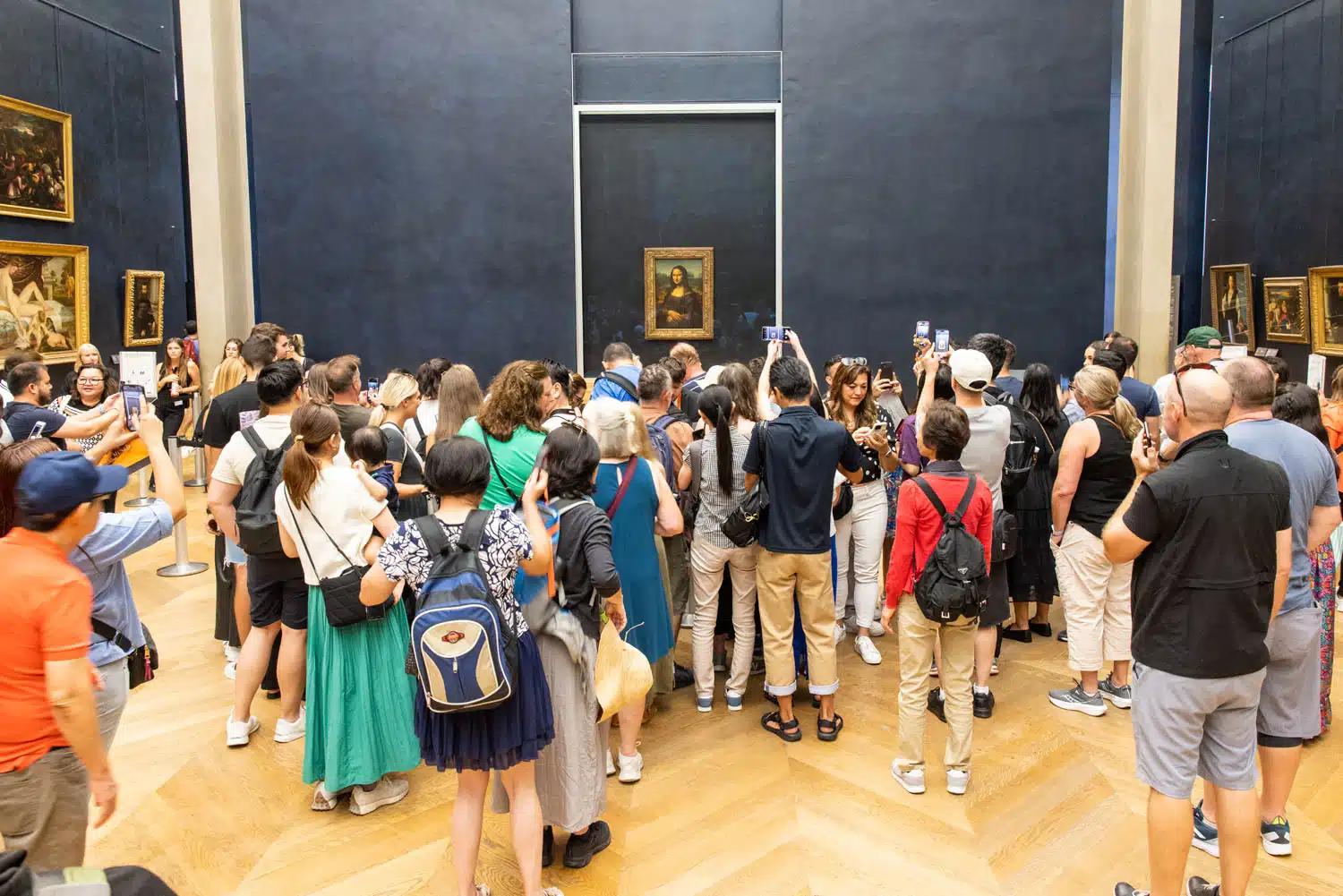
The Mona Lisa is facing a giant painting called The Wedding Feast at Cana. So, after seeing the Mona Lisa turn around to see this other masterpiece. This massive painting was created by Paolo Veronese in 1563. It depicts the story where Jesus converted water into wine during the Wedding at Cana.
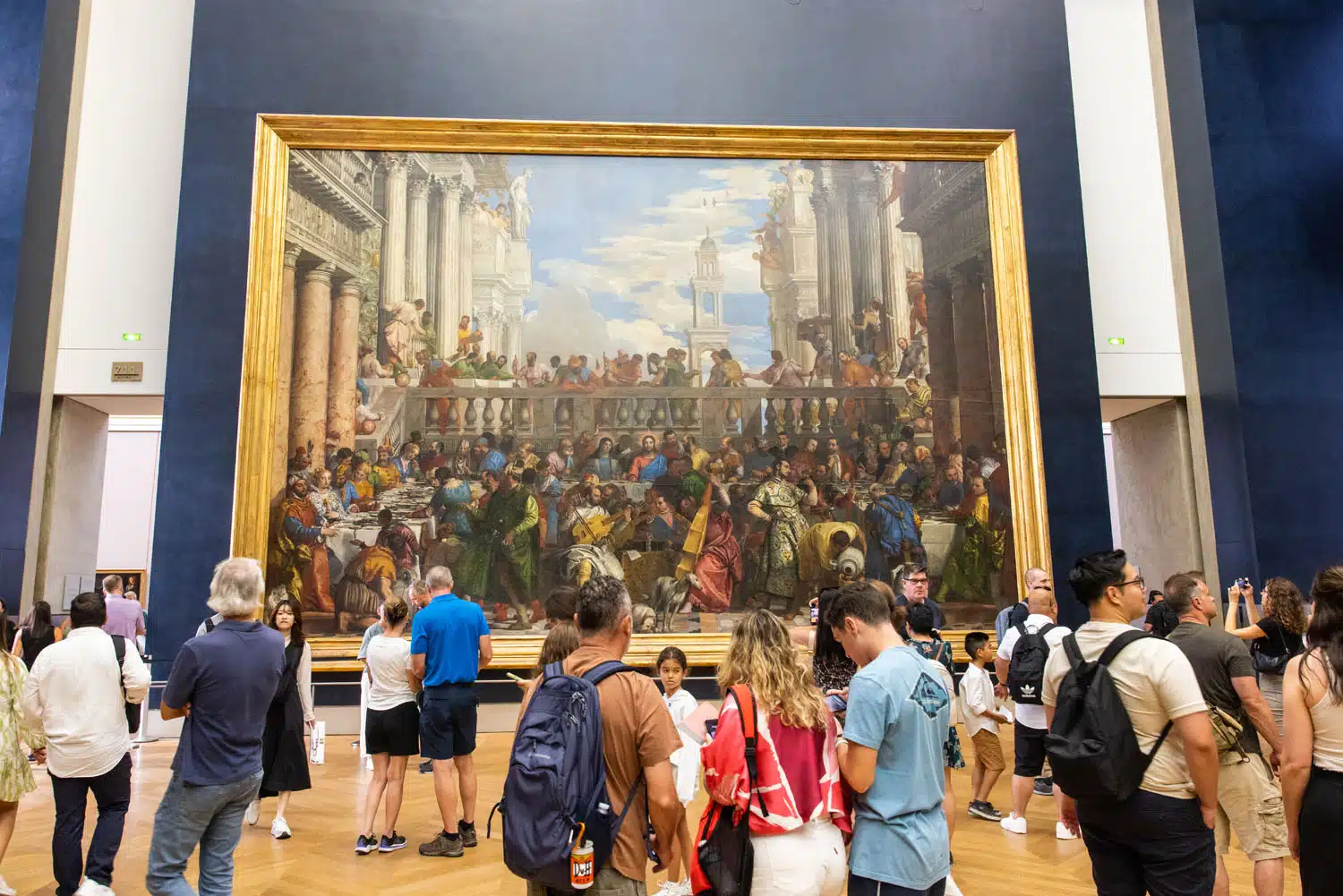
Wedding Feast at Cana
Traffic through 711 is one-way. To exit the room, walk past the Mona Lisa and enter room 701.
This large room contains a souvenir shop and a beautifully painted ceiling. It’s worth a quick photo.
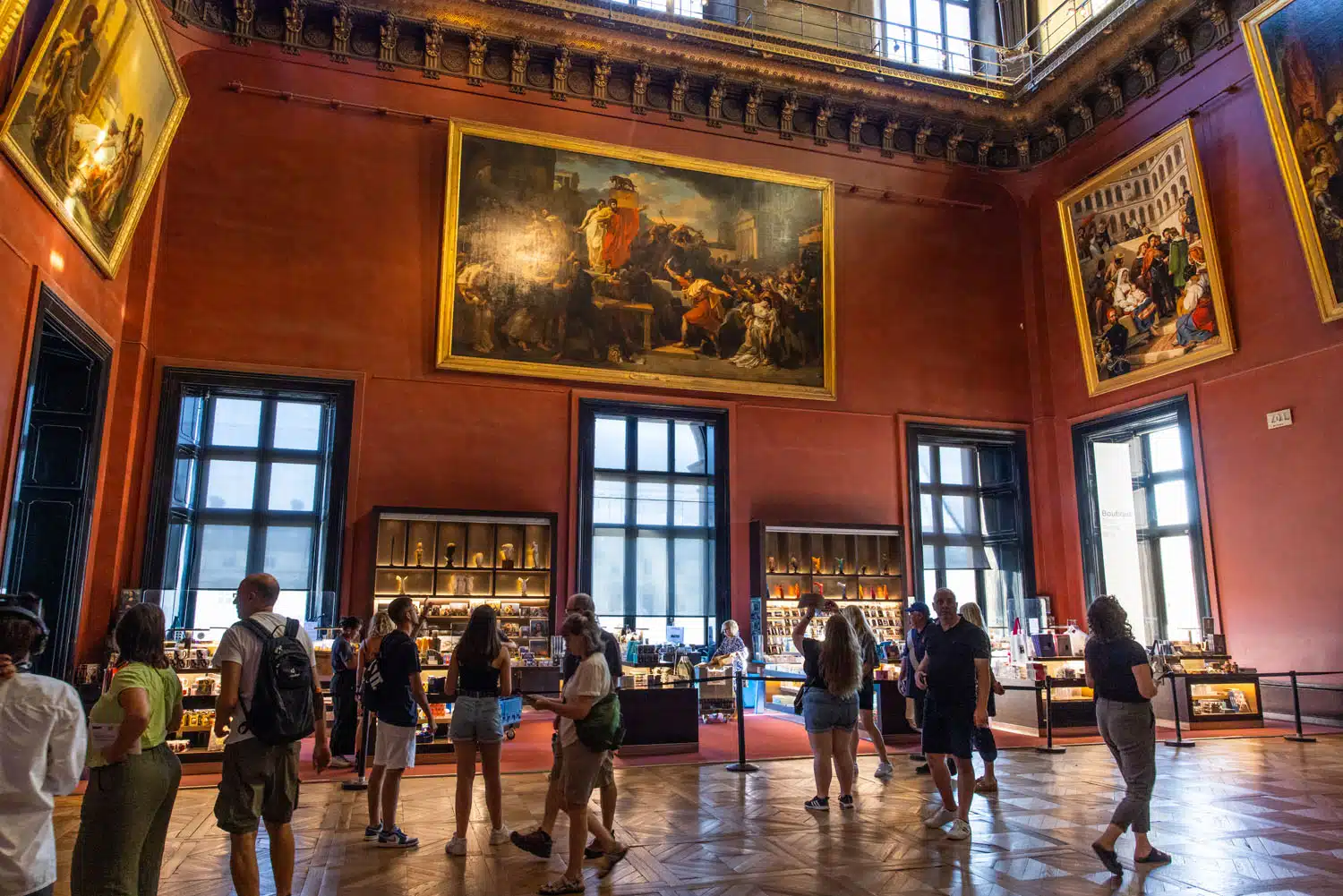
Room 701
Napoleon’s Consecration
From room 701, turn right and enter room 702. You know you are in the correct room if you can see Winged Victory through the doorway on the far end of this room.
Halfway down the wall on the left is the largest painting in the room. This painting, which has the very long official name of the Consecration of the Emperor Napoleon I and Coronation of the Empress Josephine in the Cathedral of Notre-Dame de Paris on 2 Dec 1804, was painted by Jacques-Louis David.
Historically, Napoleon crowned himself. In this painting, David portrays Napoleon crowning Josephine with the Pope blessing the Empress.
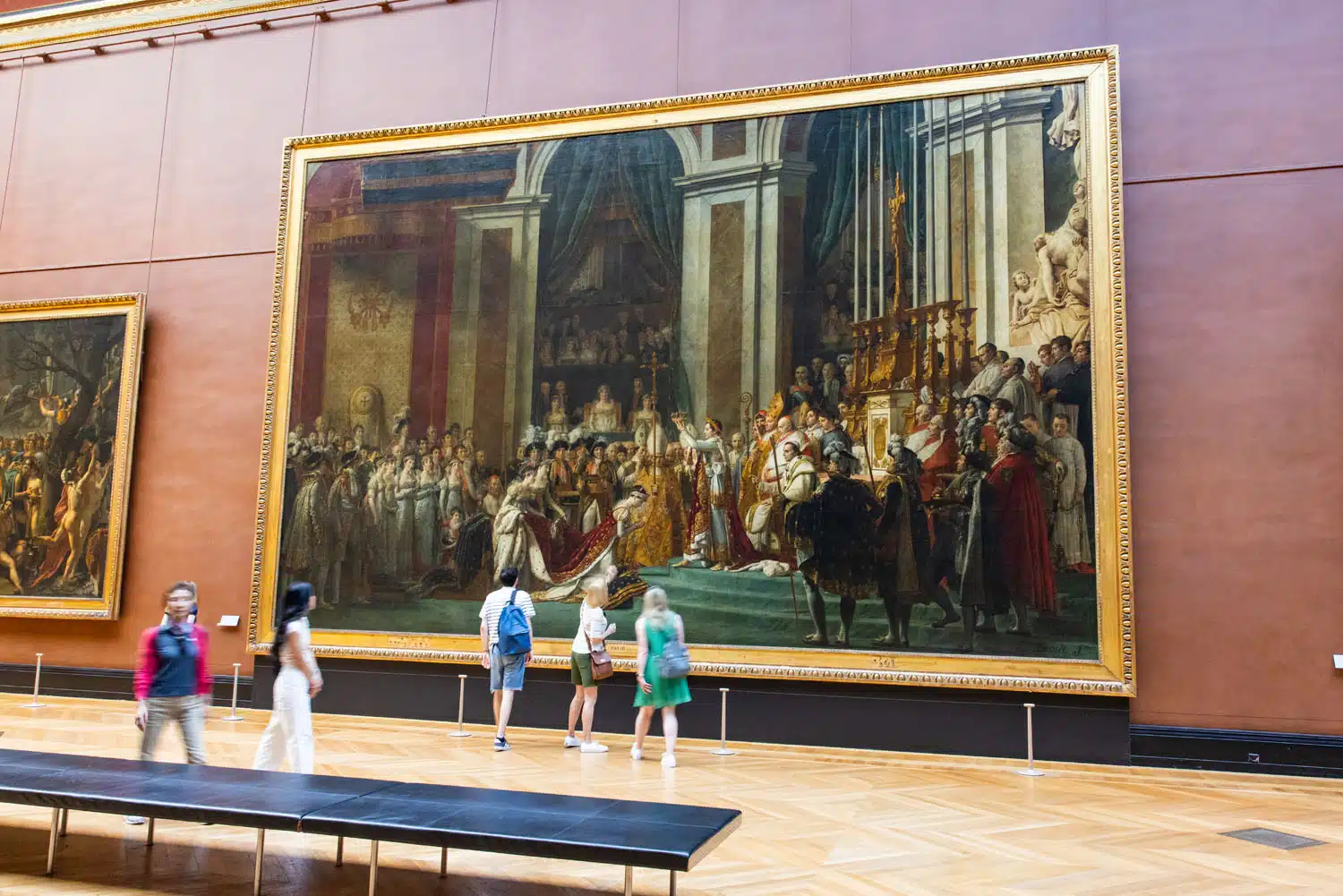
Napoleon’s Consecration
Raft of Medusa & Liberty Leading the People
Now back track to the room with the gift shop (701) and continue straight through that room and enter another long room (700).
About halfway on the left is The Raft of the Medusa by Theodore Gericault, an icon of French Romanticism.
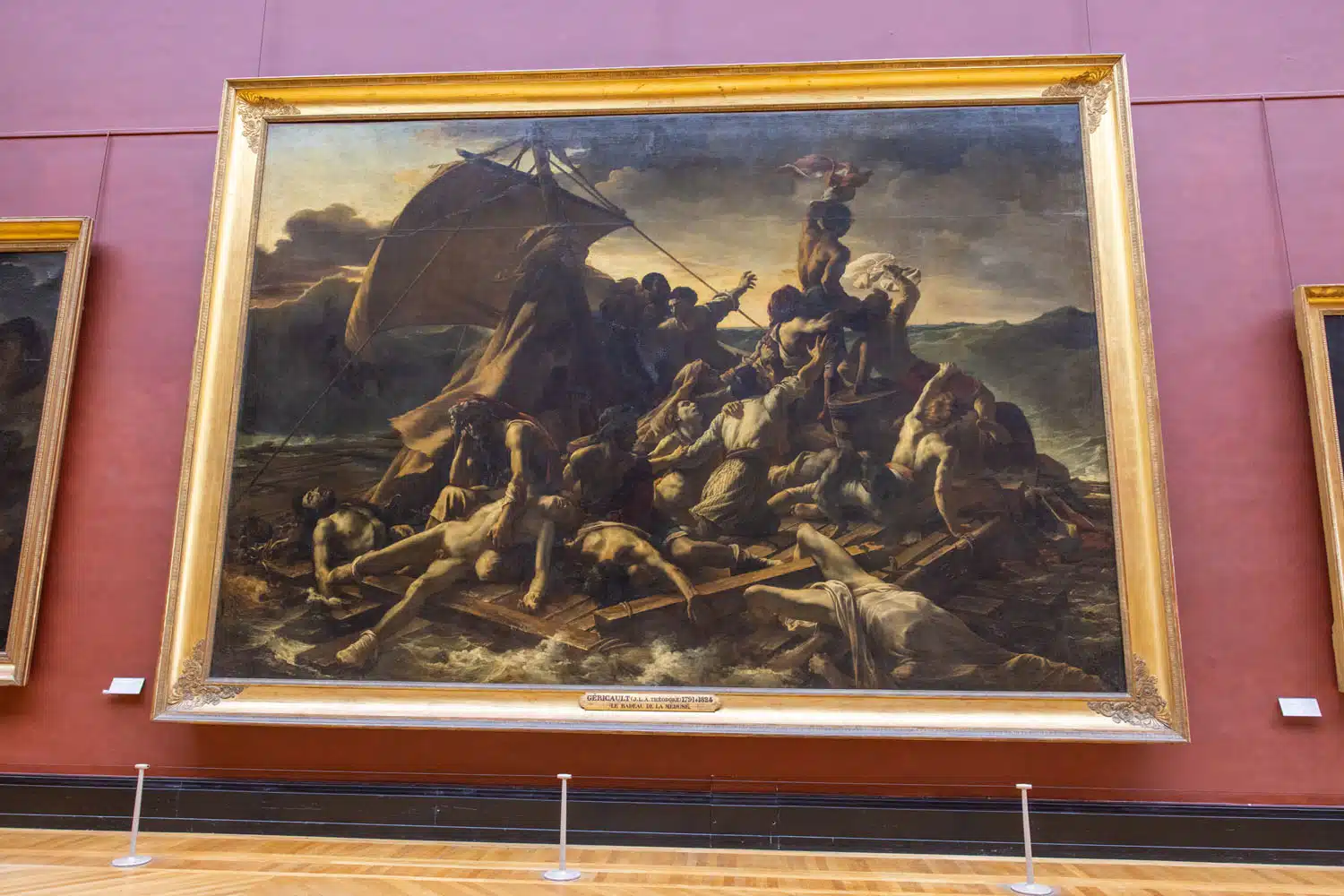
Raft of Medusa
In the same room is Liberty Leading the People by Eugene Delacroix. This painting commemorates the July Revolution of 1830 which toppled King Charles X.
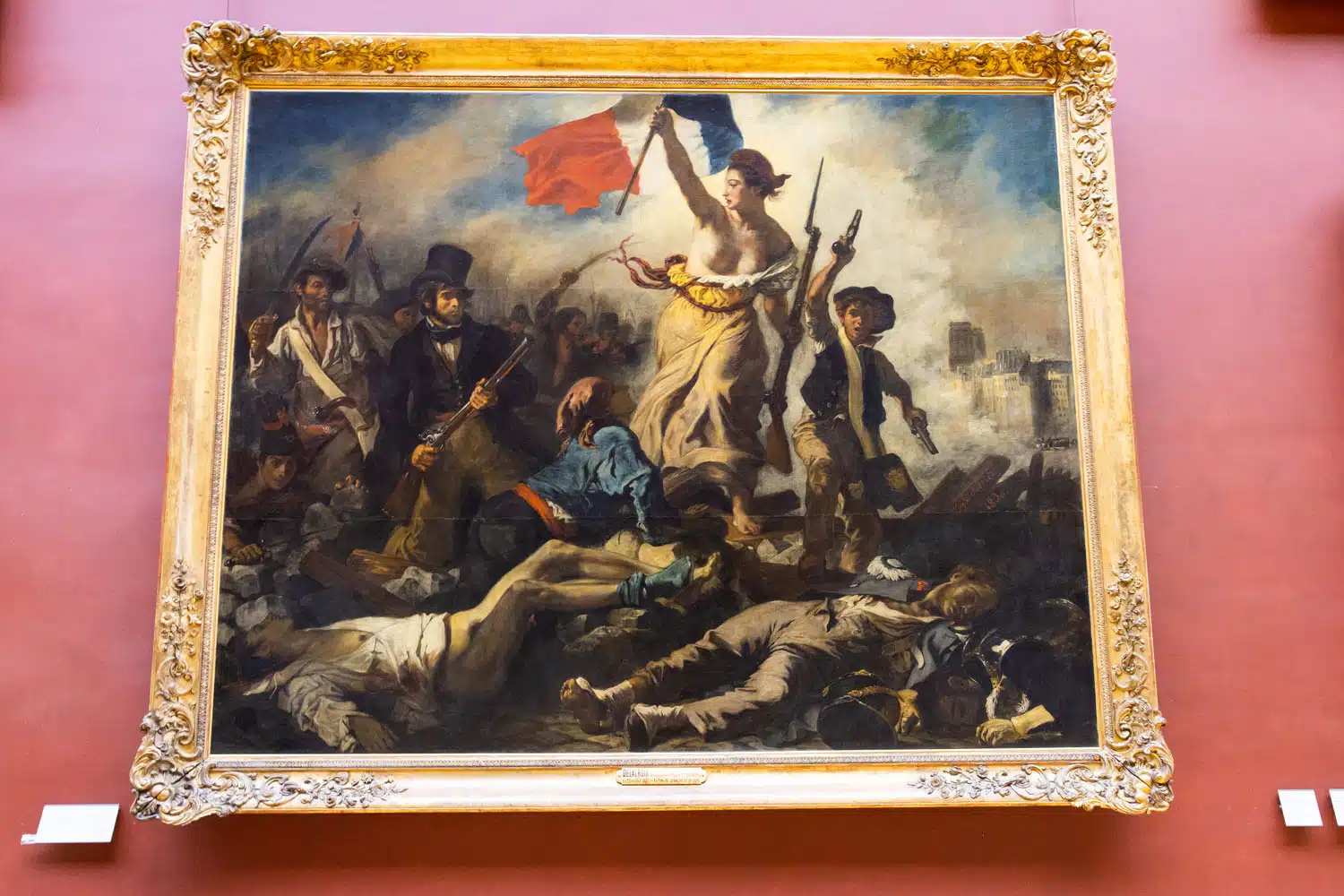
Liberty Leading the People
Café Molien
Exit the far end of this room and you will come upon a cafe on the right, Café Molien. The Cafe does not open until 10:15 am. We made it here at 9:40 am but we moved very quickly through the Louvre. If it is open, you have the option to take a break, have a coffee or a snack, and enjoy the view. This café has an open terrace with a great view of the Pyramid (we returned to the café later in the day to take the photo below).
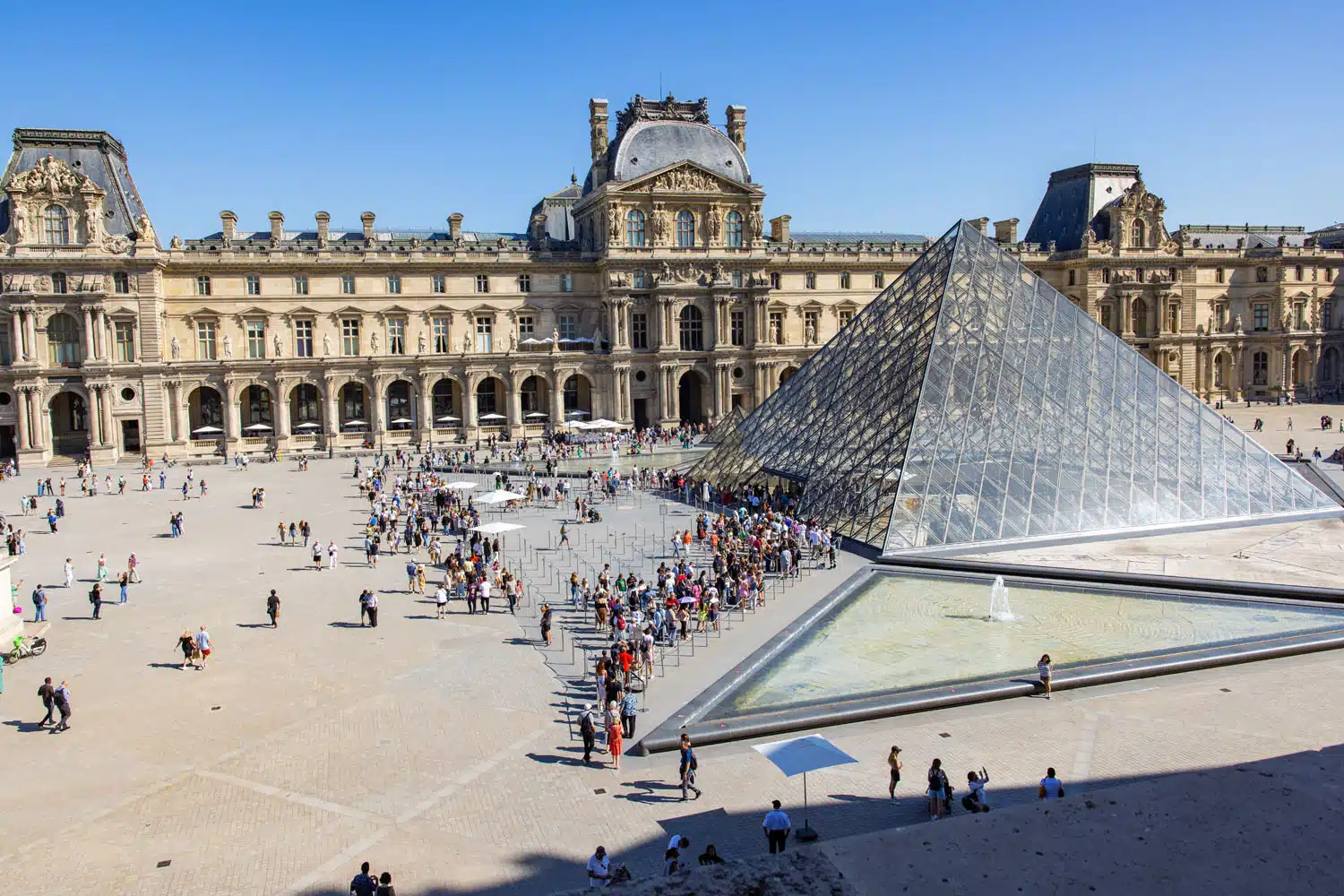
The view from Cafe Molien | How to visit the Louvre
Michelangelo’s Slaves
Next to the cafe, descend down the large staircase to room 403. A short distance into the room are two sculptures, the Rebellious Slave and the Dying Slave, both of which were carved by Michelangelo.
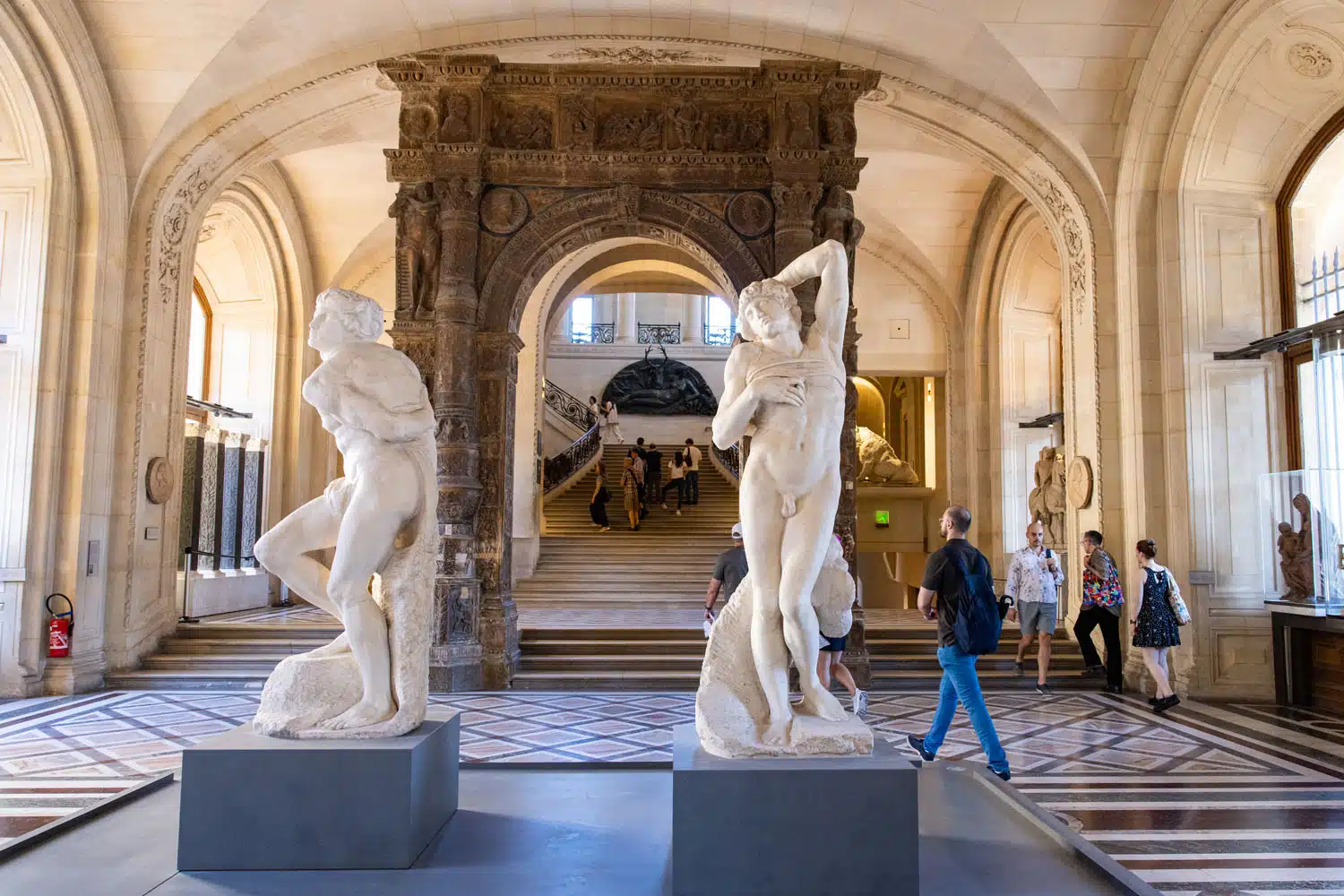
Michelangelo’s Slaves
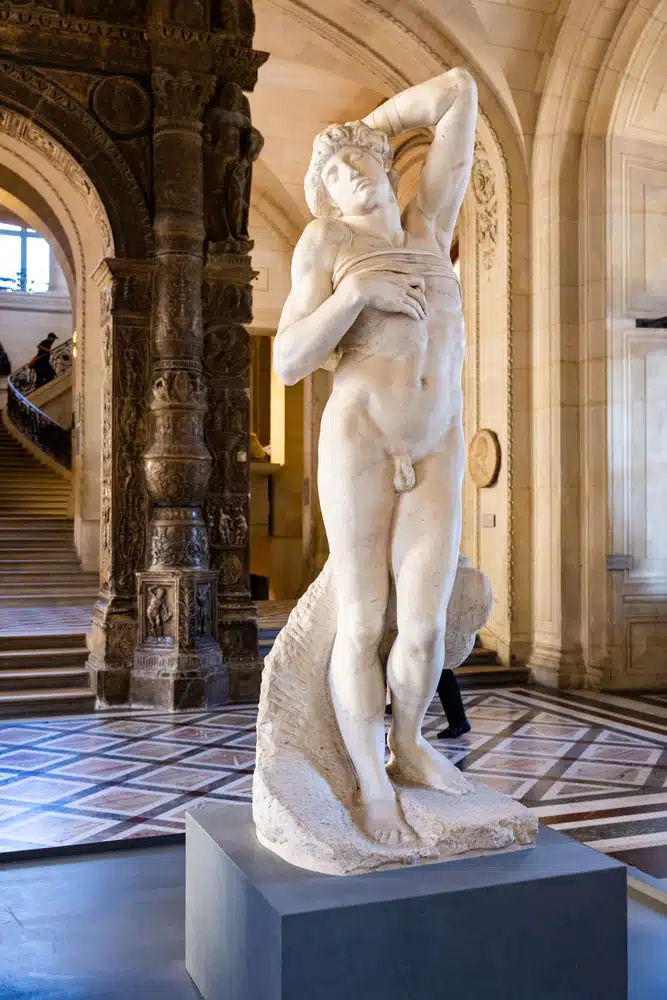
Dying Slave
Continue to the far end of room 403 to see Psyche Revived by Cupid’s Kiss by Antonio Canova.
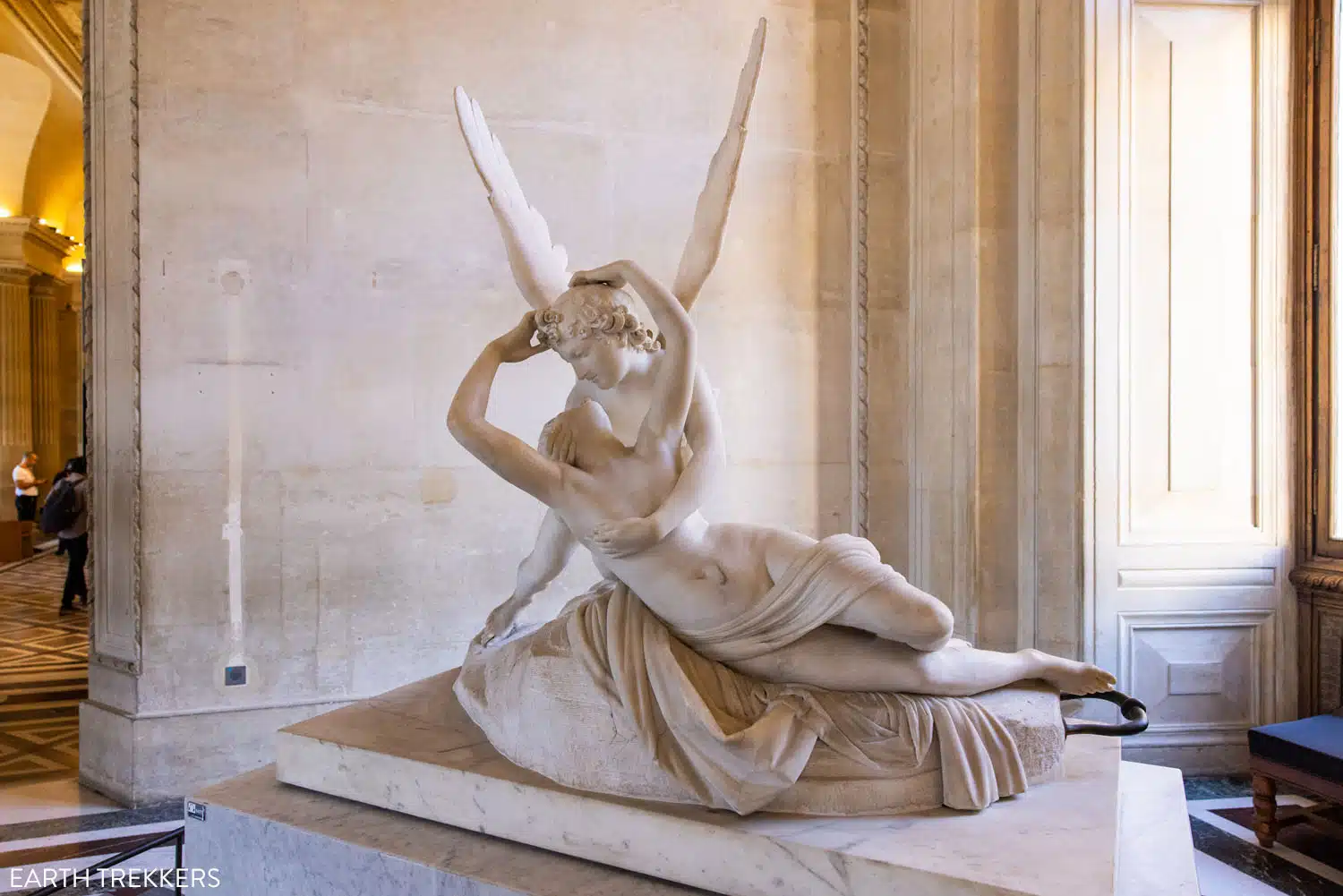
Psyche Revived by Cupid’s Kiss
Optional: Exit the Louvre
At this point you have a choice to make: continue through the Louvre or exit the Louvre. Depending how quickly you moved through the rooms of the Louvre, and whether or not you stopped at Café Molien, it has been an hour to an hour and a half.
To exit the Louvre, leave room 403, go down the steps, enter room 404, go down the spiral staircase, following signs for the exit (sortie).
Part 2: Medieval Louvre & Ancient Egypt
Time: 1 to 1.5 hours
If you choose to continue through the Louvre, you will now travel back in time to medieval Paris and ancient Egypt.
Things you will see include:
- Greek Antiquities
- Medieval Louvre
- The Great Sphinx of Tanis
- Egyptian Antiquities
The Route to Medieval Louvre
To get to Medieval Louvre, it is a short walk back through the Denon Wing to the Sully Wing. Here is the route.
From room 403, walk down the steps, enter room 404, and continue straight through to room 406 (Galerie Daru). At the far end of the room, only go up a few steps (don’t go all the way up to Winged Victory) and follow the hallway to the left to go back down some steps.
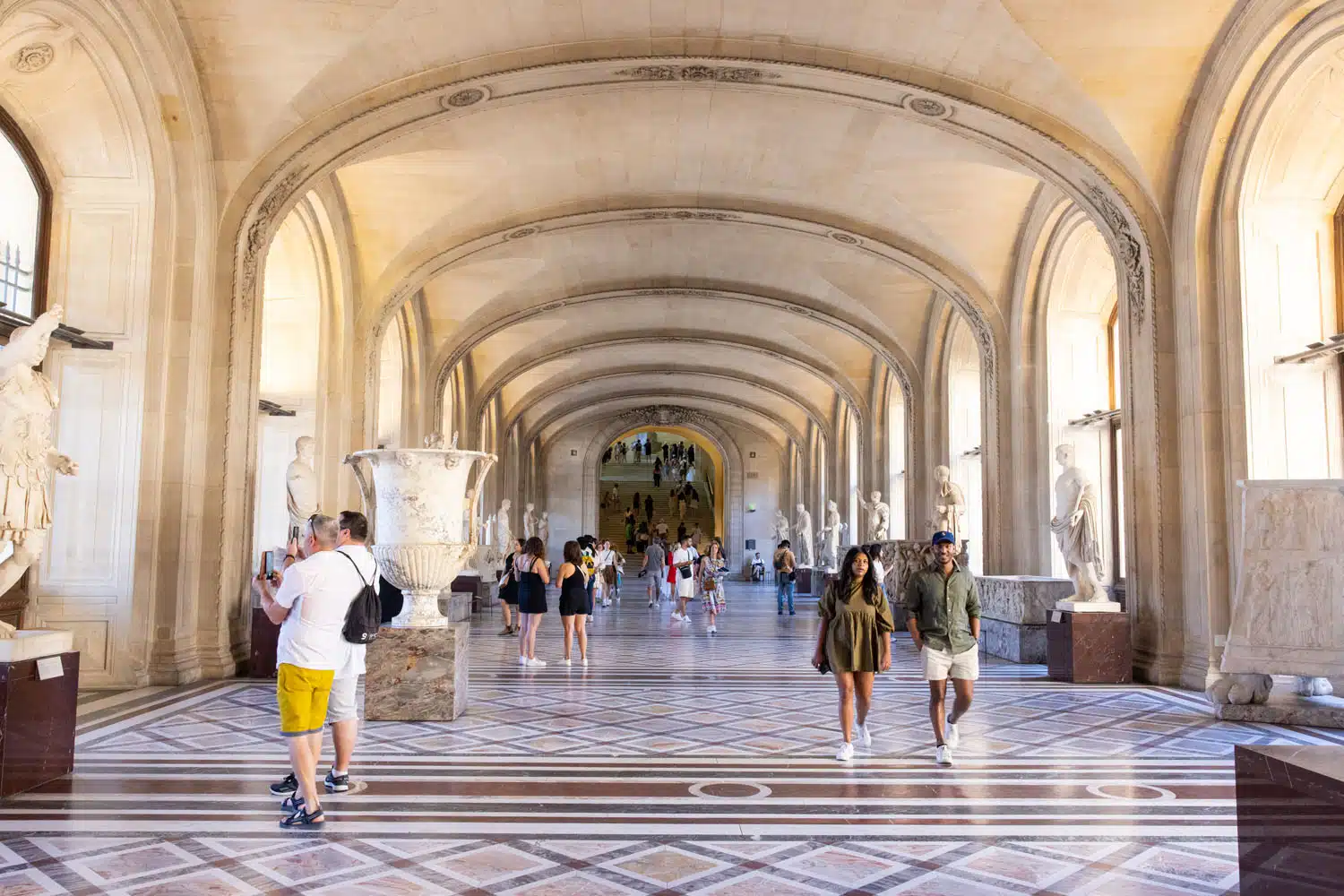
Galerie Daru | How to visit the Louvre
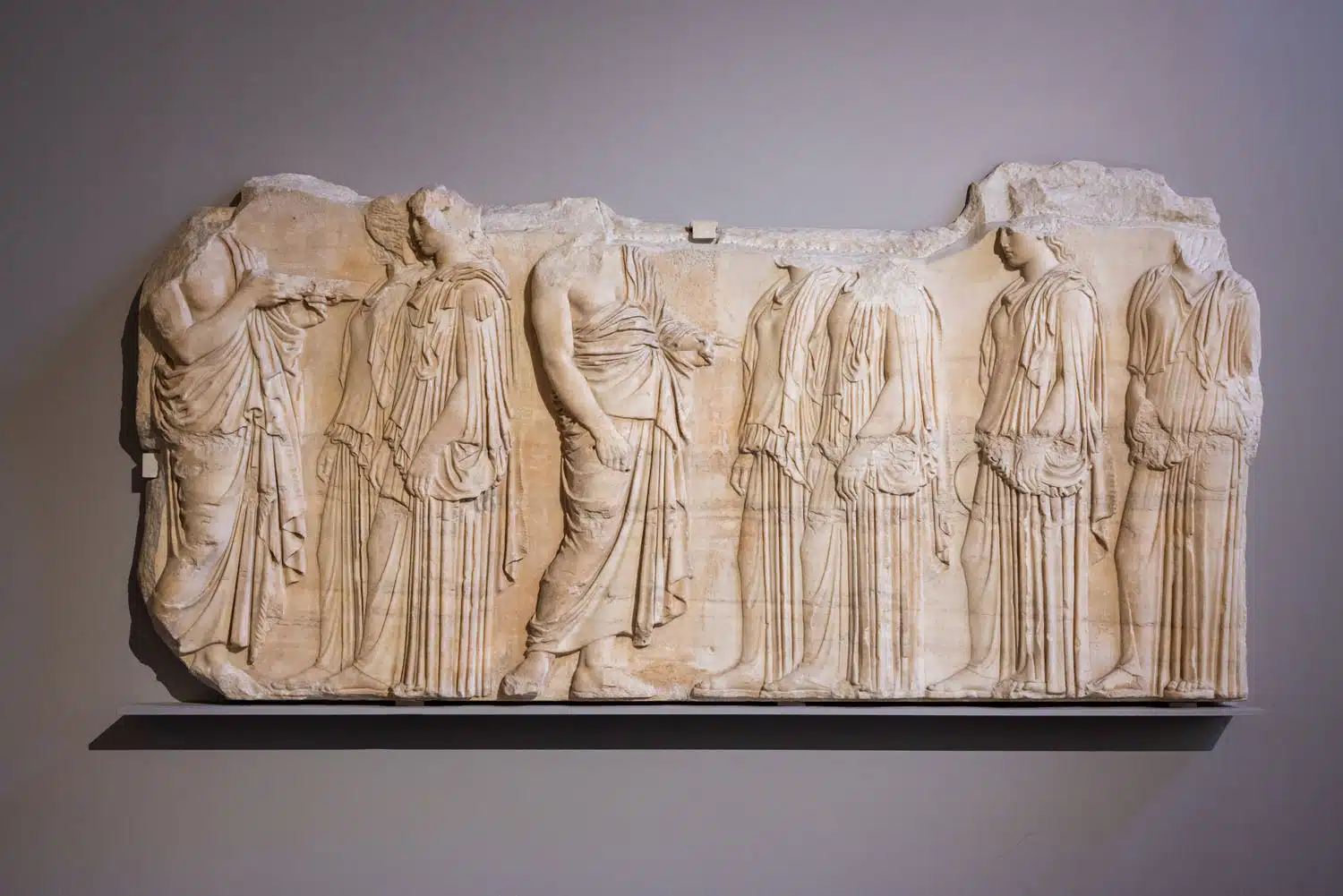
A piece of the Parthenon in Salle de Diane
Walk through room 347 (Salle de Diane) which contains Greek antiquities and pieces of the Parthenon. Then continue through room 345 and see the crowds around Venus de Milo.
Walk until Venus de Milo is on your right and then turn left into room 348 (Salle des Cariatides). Walk through the room and out the opposite side. Turn left and then go down the stairs. At bottom of steps swing a hard right almost like a U turn and then walk straight until you enter a room with stone walls (room 133). This is the Medieval Louvre.
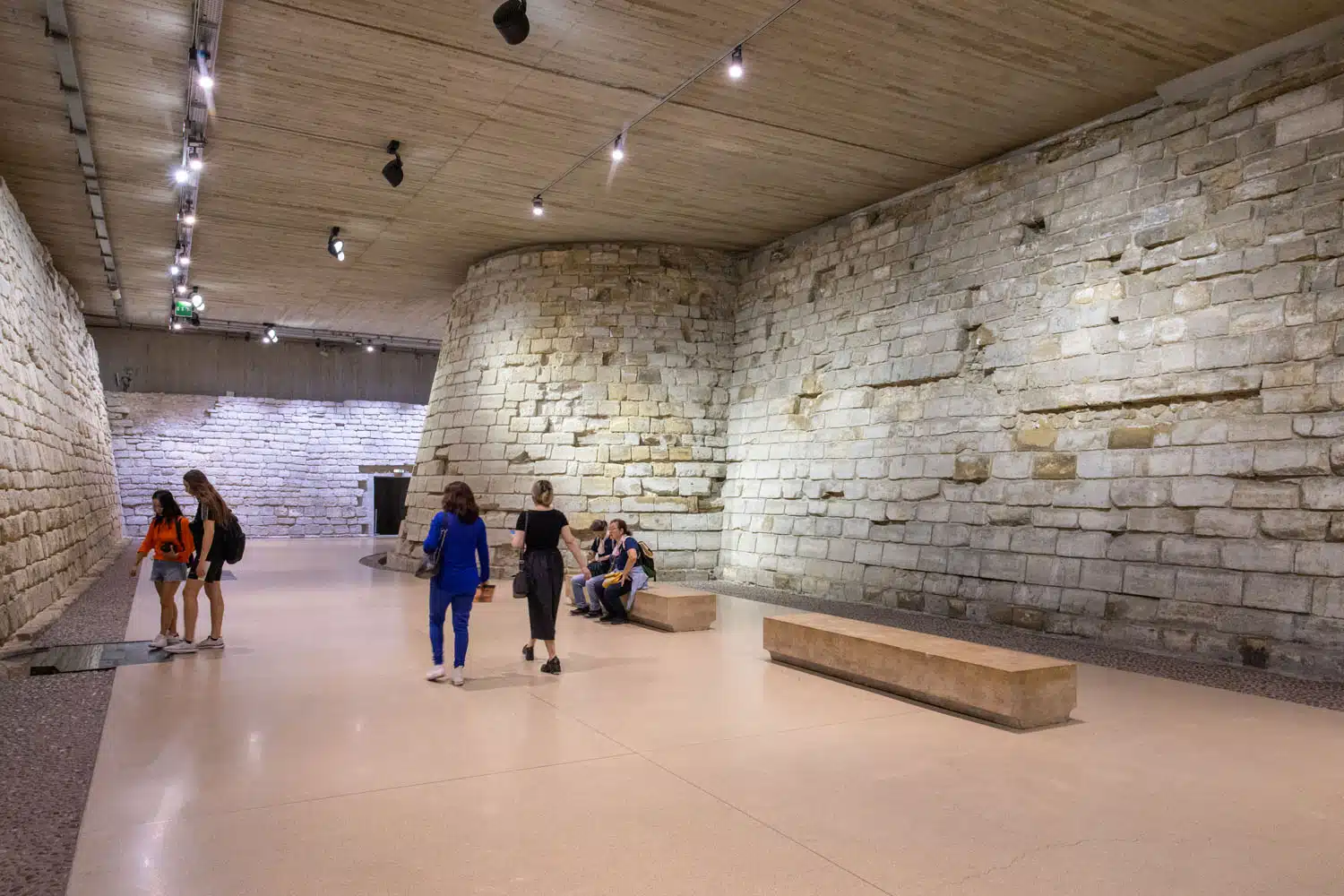
Medieval Louvre
Medieval Louvre
In the Medieval Louvre, you can see the original walls when the Louvre was used as a fortification, before it became a palace. What you are looking at are the foundations of the castle walls, before they were transformed into the Louvre we see today.
The Medieval Louvre is located on the lowest level of the Sully Wing, in a section of the palace called the Pavillon de l’Horloge.
The Great Sphinx of Tanis
Continue walking along the stone walls in room 133 until you reach a staircase in front of you with an archway labeled “Louvre Sully Medieval”.
Walk up the staircase to see the Great Sphinx of Tanis (room 338, the Crypte du Sphinx). This granite sphinx dates back to the 26th century BC and was discovered in the temple of Amun-Ra in Tanis, Egypt.
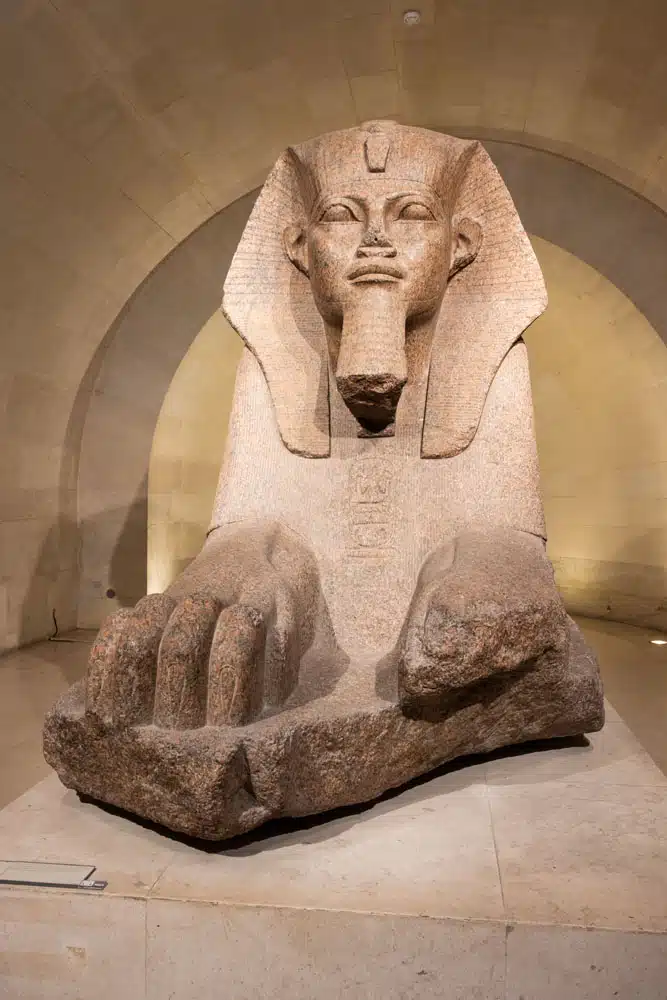
Great Sphinx of Tanis
Egyptian Antiquities
Go up the staircase to the left of Sphinx. This leads you to several rooms containing the Egyptian Antiquities.
These rooms are a treasure trove of Egyptian artifacts, with hieroglyphics, sarcophagi, relief murals from ancient Egyptian temples, and statues of Egyptian gods. In these rooms are some of the oldest artifacts in the Louvre and if you have an interest in Egyptian history and mythology, it would be easy to spend a lot of time here.
This was one of our favorite parts of the Louvre.
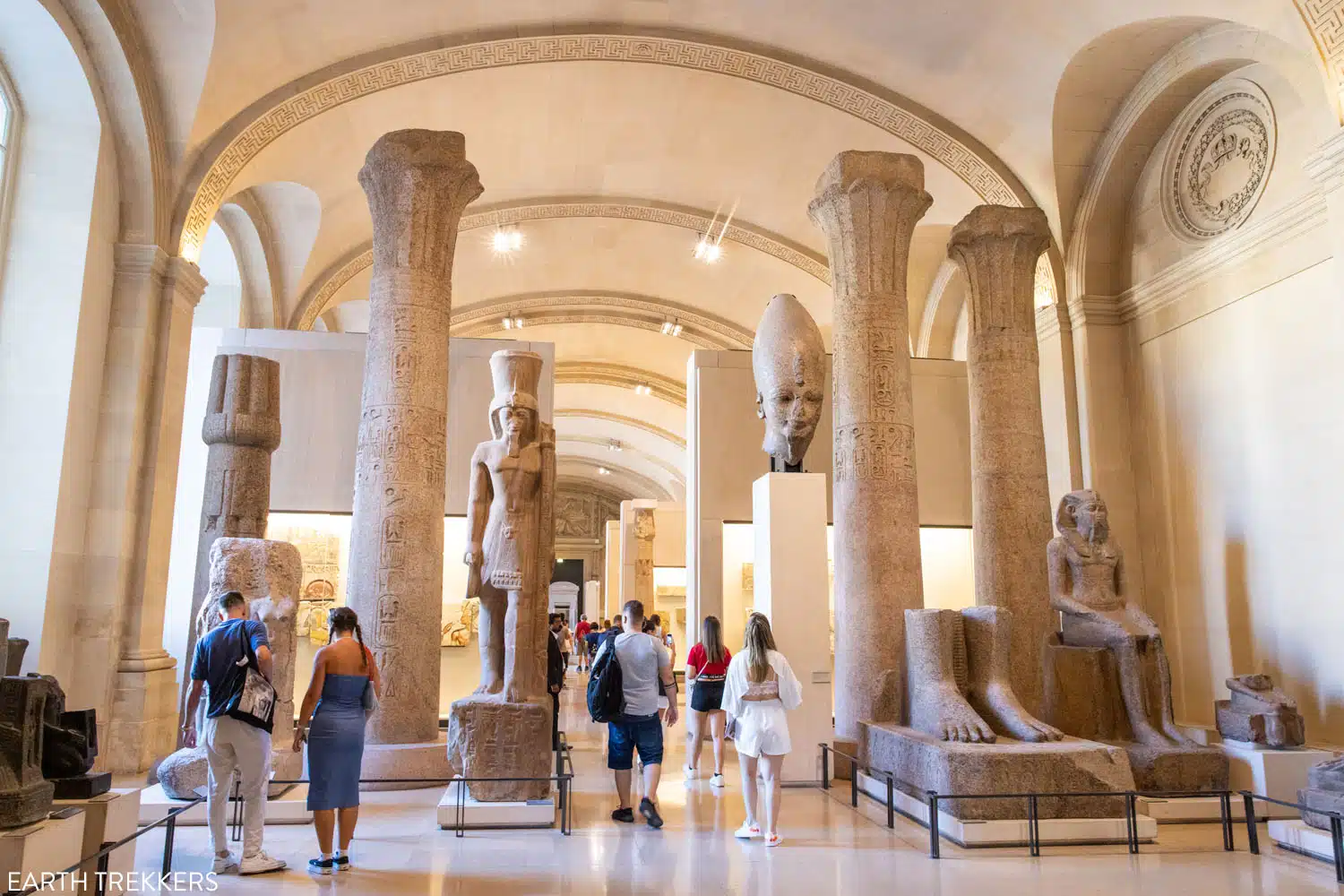
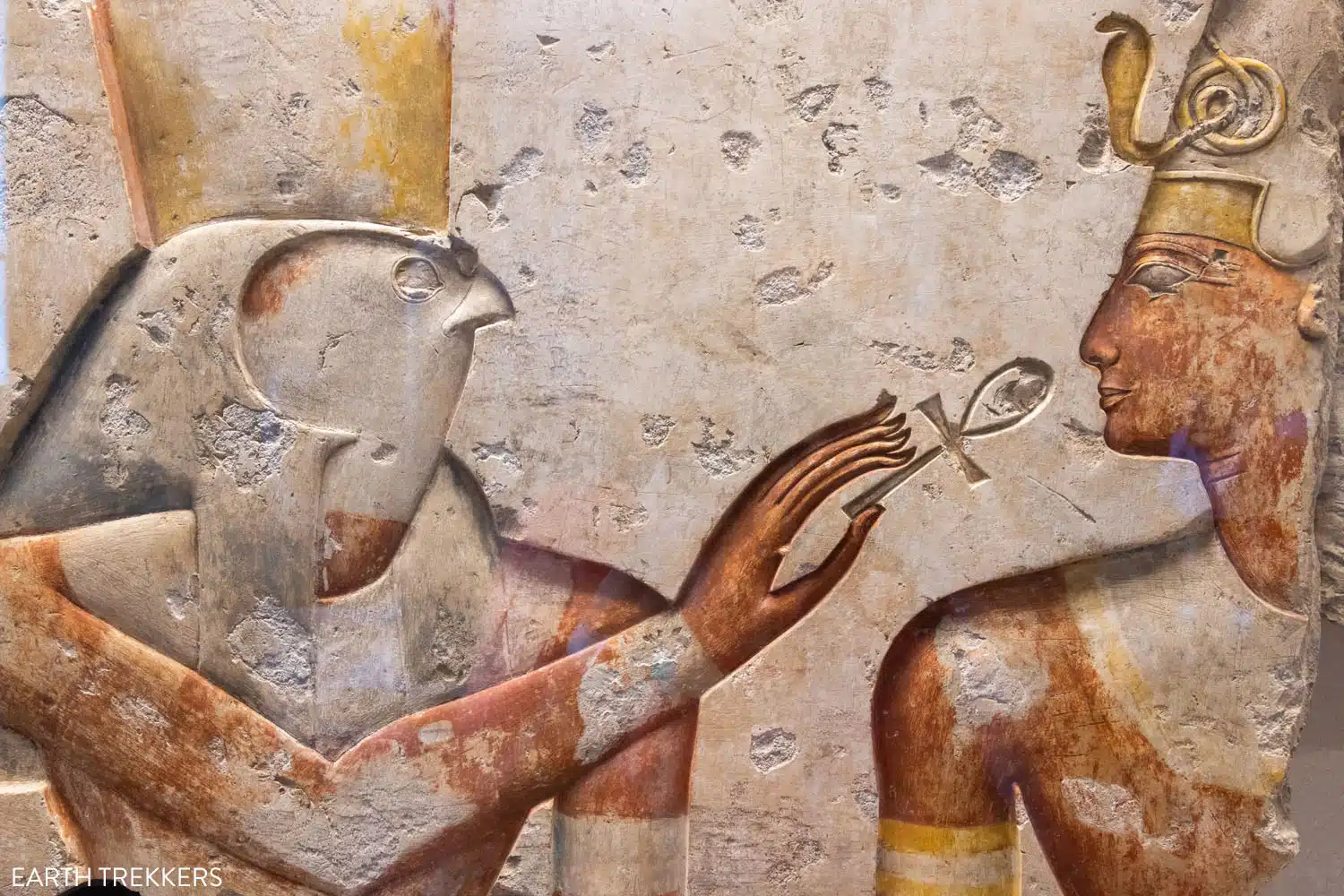
As you weave your way through the Egyptian galleries, follow signs for “Sens de la visite.”
Keep walking through the Egyptian galleries until you enter room 324. In this room there are steps down in front of you. Take these down to Crypte d’Osiris.
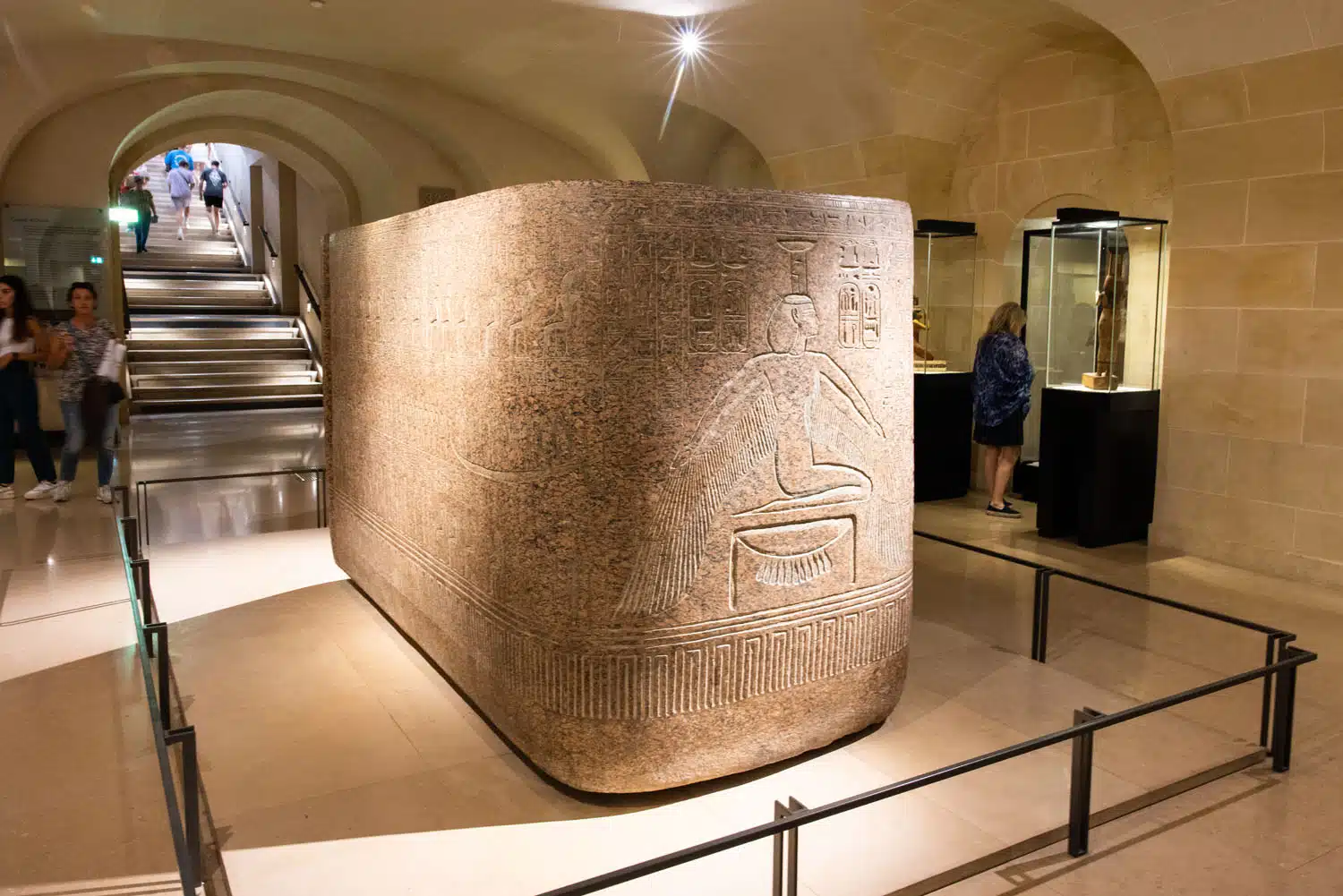
Crypte d’Osiris
Walk up the stairs on the other side of the room to walk through several rooms filled with sarcophagi (rooms 322, 321, and 320).
At this point, you can continue on the walking tour of the Louvre or end your visit. To exit the Louvre, follow signs to the exit (sortie).
Part 3: The Richelieu Wing
Time: 1 to 2 hours
This final part of our walking tour takes you through a portion of the Richelieu Wing. There are a wide range of things to see here, from Napoleon’s apartments, ancient Mesopotamian artifacts, paintings by Dutch masters, and the opportunity to take a break with a sweet treat at Angelina’s.
Things you will see include:
- Napoleon III’s Apartments
- The Code of Hammurabi
- Lamassus of Khorsabad Palace
- The Cour Puget
- Angelina’s
Terrasse Colbert & Angelina’s
From room 320, walk up the stairs to level 1 on the Sully Wing to room 632 to enter the Object d’art.
The first room you see is the royal residence of Marie Antoinette who was queen of France from 1774 to 1792.
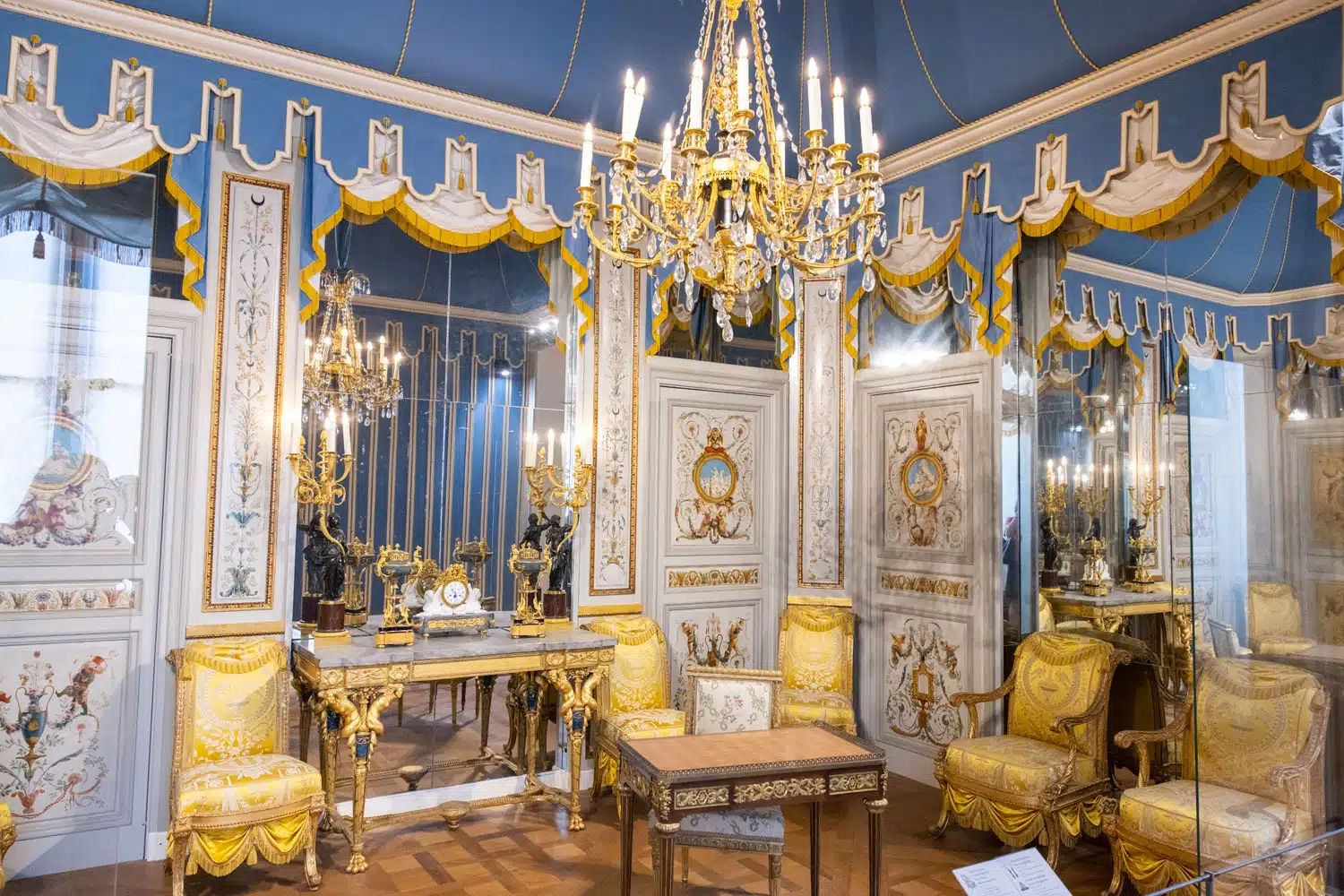
Room from the royal residence of Marie Antoinette | How to visit the Louvre
Continue walking straight, past small rooms filled with royal furnishings and art pieces. On this walk, you will enter the Richelieu Wing.
You will eventually come to some escalators. Walk past the escalators, remaining on level 1, until you get to Terrasse Colbert on the left. At this point, you can stop here for a snack or drink at one of two places.
Terrasse Colbert has the best view. From the open terrace, you overlook the Pyramid, making this one of the best viewpoints of the Louvre. On the menu is coffee and snacks.
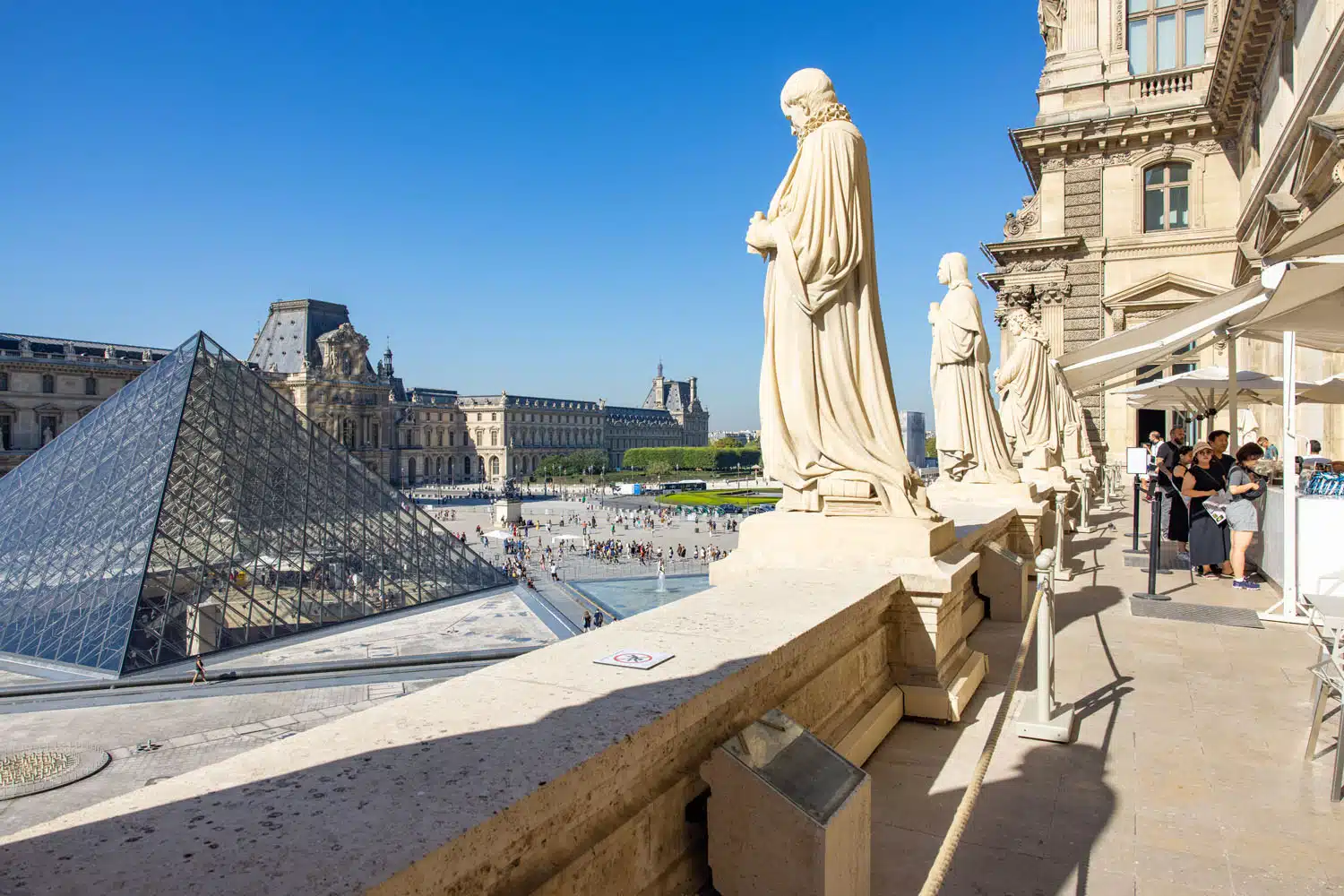
Terasse Colbert
Next to Terrasse Colbert is Angelina’s (also called Café Richelieu). This restaurant is famous for its hot chocolate and pastries. Their main location is on Rue de Rivoli and it’s also famous for its very long line to get a seat. However, here at the Louvre, there is a good chance you will have a much shorter wait. The view isn’t as good, since Angelina’s does not have an open terrace, but their decadent pastries are amazing. We recommend having the Richelieu, a pyramidal-shaped chocolate pastry that you can only get at their Louvre location. See their menu here.
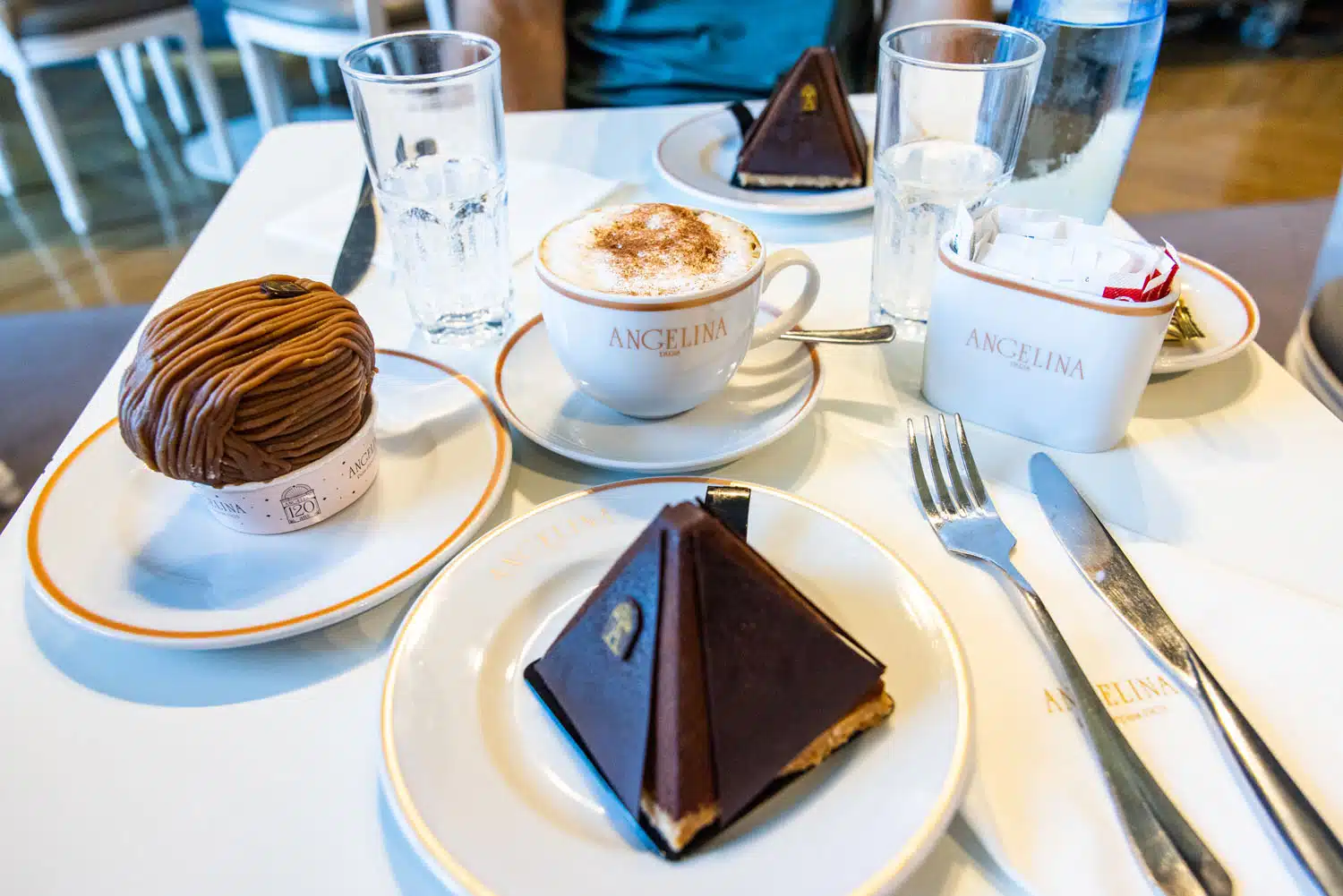
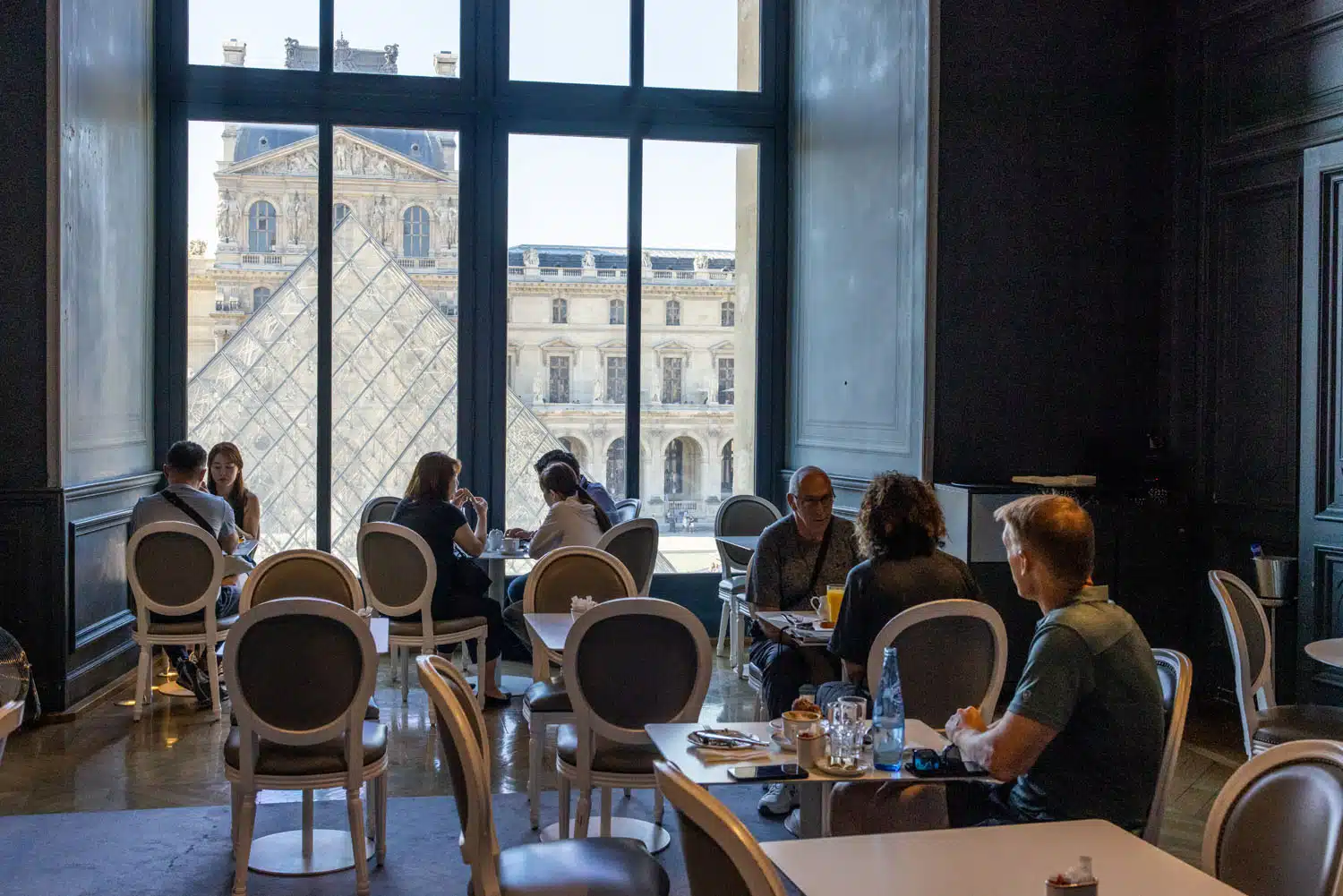
Angelina’s
Napoleon III’s Apartments
If you want to tour Napoleon III’s Apartments, the entrance is next to Angelina’s/Café Richelieu. We were unable to tour the apartments, since this was one of the sections that were closed on the day of our visit.
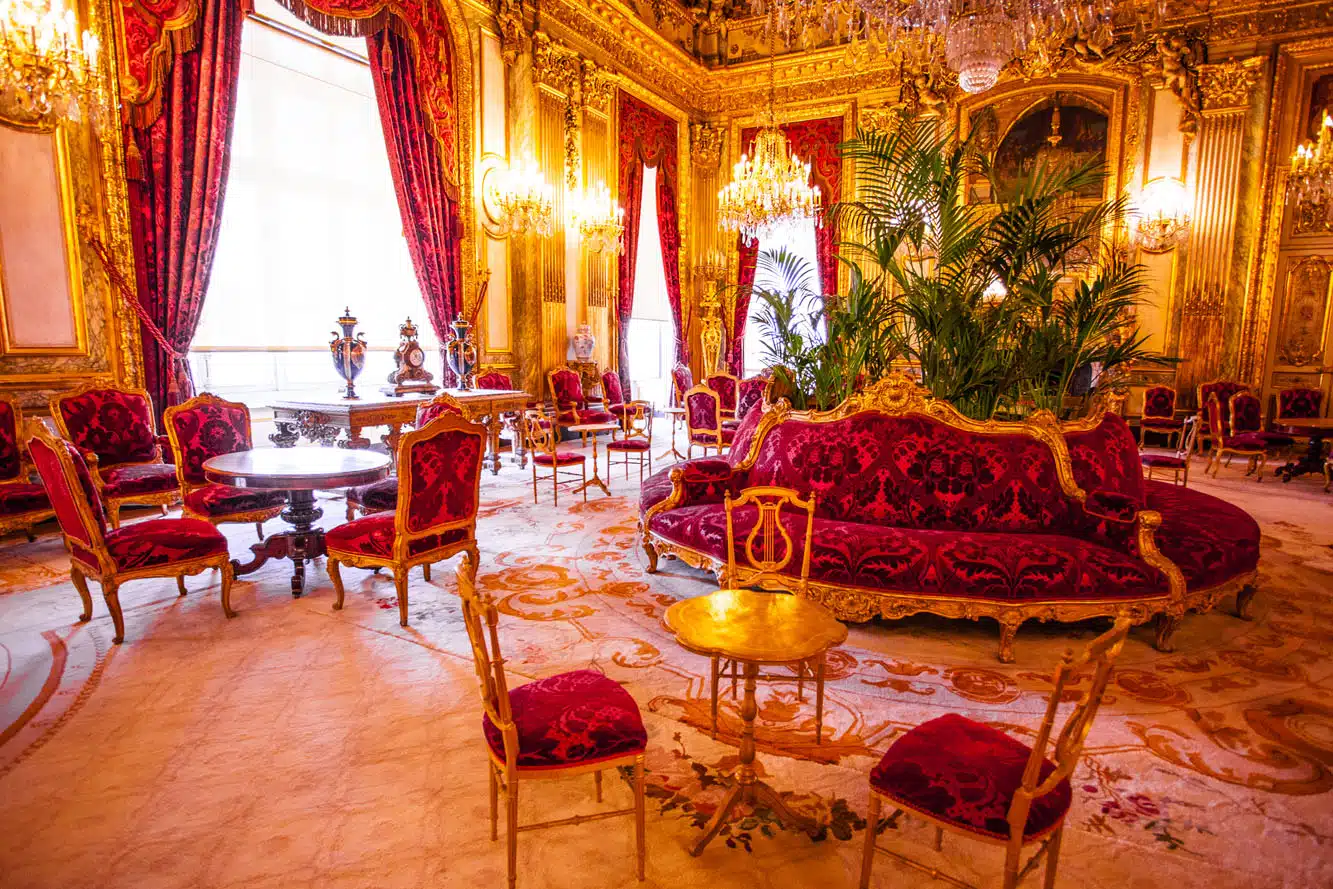
Napoleon’s Apartments | Alexandra Lande/shutterstock.com
Lamassus of Khorsabad Palace
Backtrack to the escalators, go down one level and make a U-turn off escalators and walk into Antiquities Orientales.
Walk through rooms 236 and 234 (in room 234, it’s worth a quick look at the Statue of Ebih-II, which dates back to 2,600 to 2,300 BC). Walk up a few steps to a landing, ignore the other staircases on this landing and turn left into room 228 and then immediately right into room 229.
This large room contains several Neo-Assyrian relief murals and the Lamassus of Khorsabad Palace. These Lamassus are creatures which have a human head, the wings of eagles, and the body of a bull or lion. They were added to doorways and passages in the palace of Khorsabad, in present day Dur-Sharrukin in Iraq. These Lamassus date back to sometime between 721 and 705 BC.
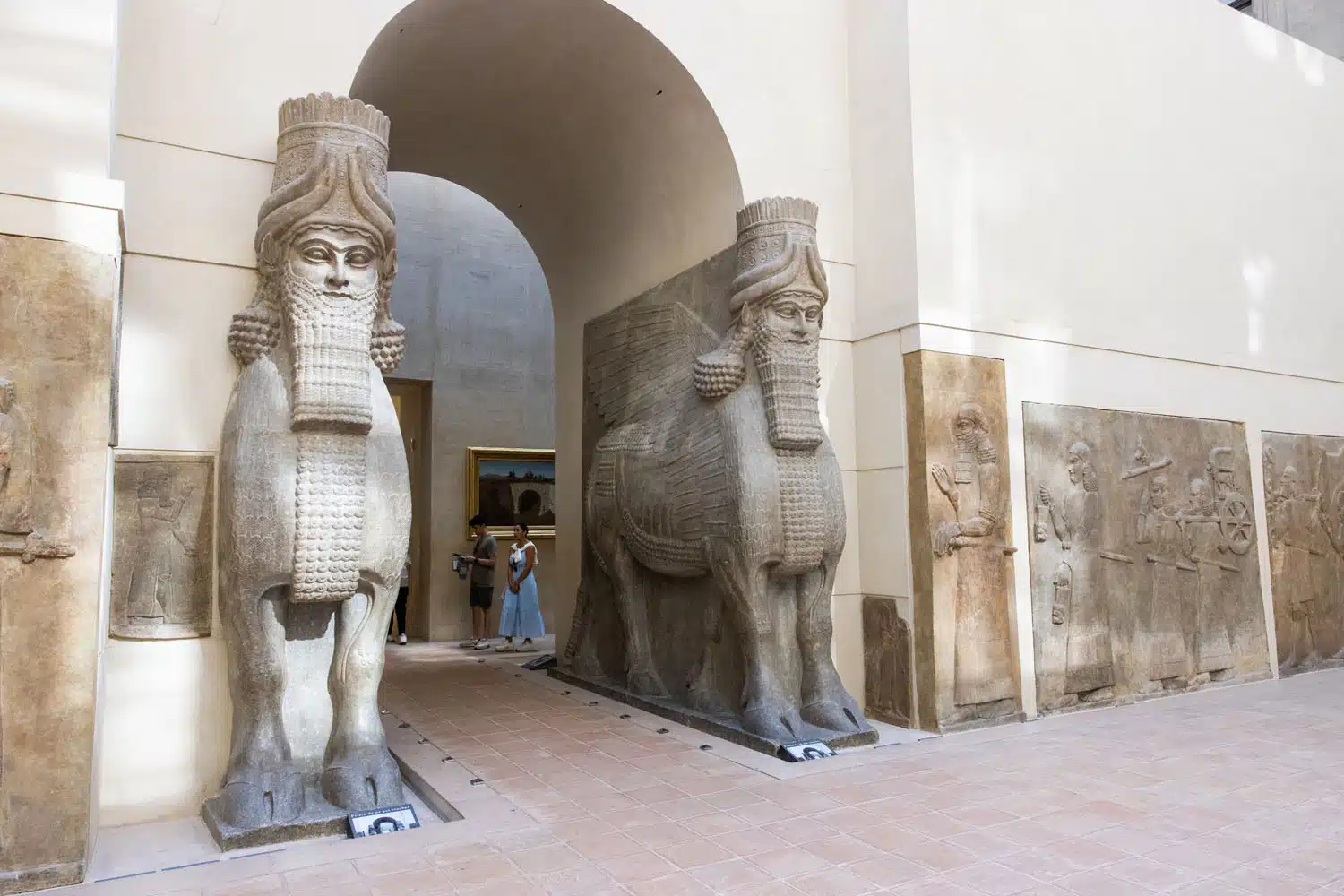
Lamassus of Khorsabad Palace
The Code of Hammurabi
From room 229, walk back into room 228. Look through the windows to Cour Puget, a courtyard in the Richelieu Wing that contains sculptures from the 17th to 19th century.
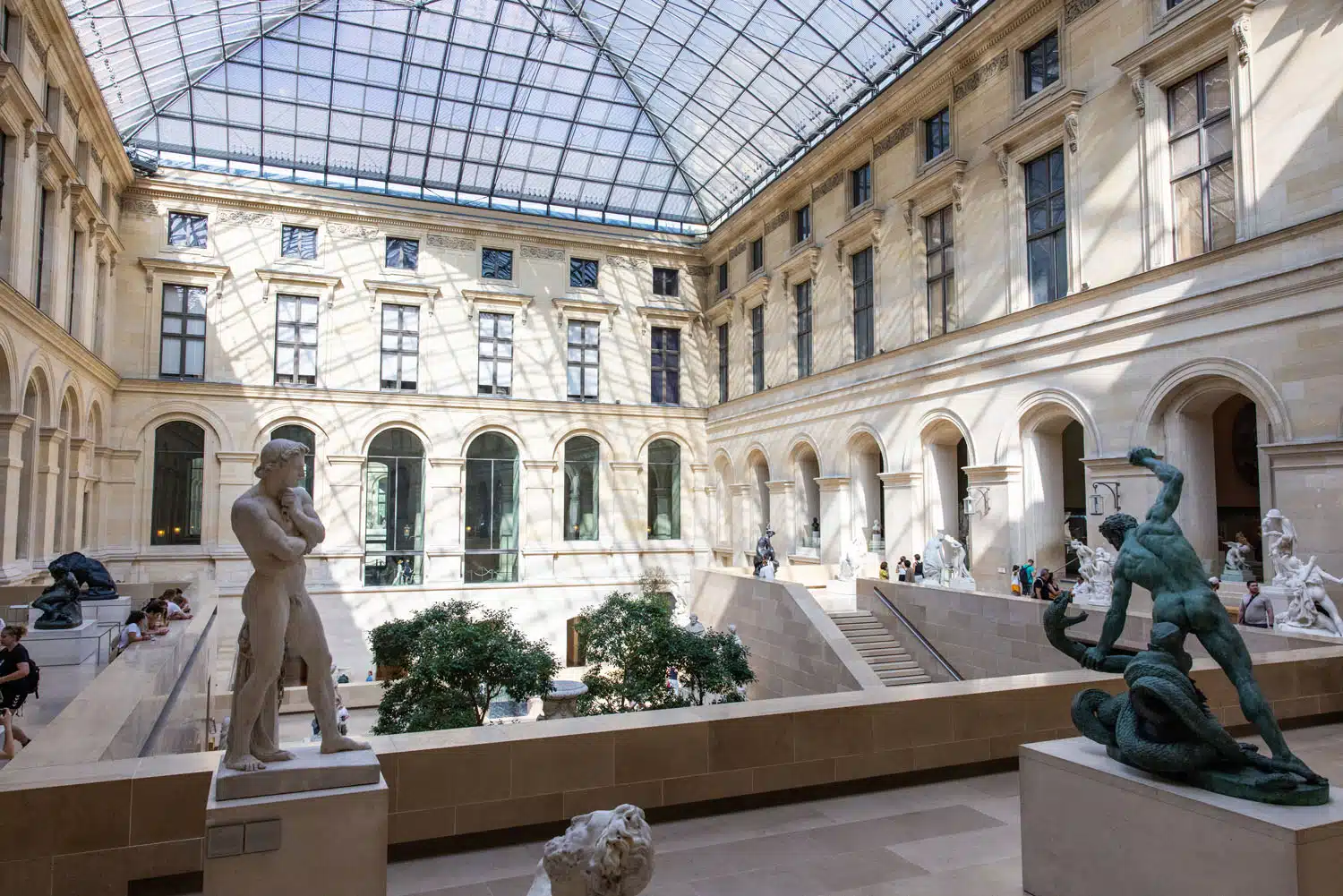
Cour Puget
From room 228, turn right into room 227. Sitting in the center of this room is the Code of Hammurabi. Created between 1755 and 1750 BC, this Babylonian legal text is written in the Old Babylonian dialect of Akkadian. It was written by Hammurabi, the sixth king of the Amorite First Dynasty of Babylon, and it is a code of laws. It is famous for being the longest and best-preserved legal text from the ancient Near East.
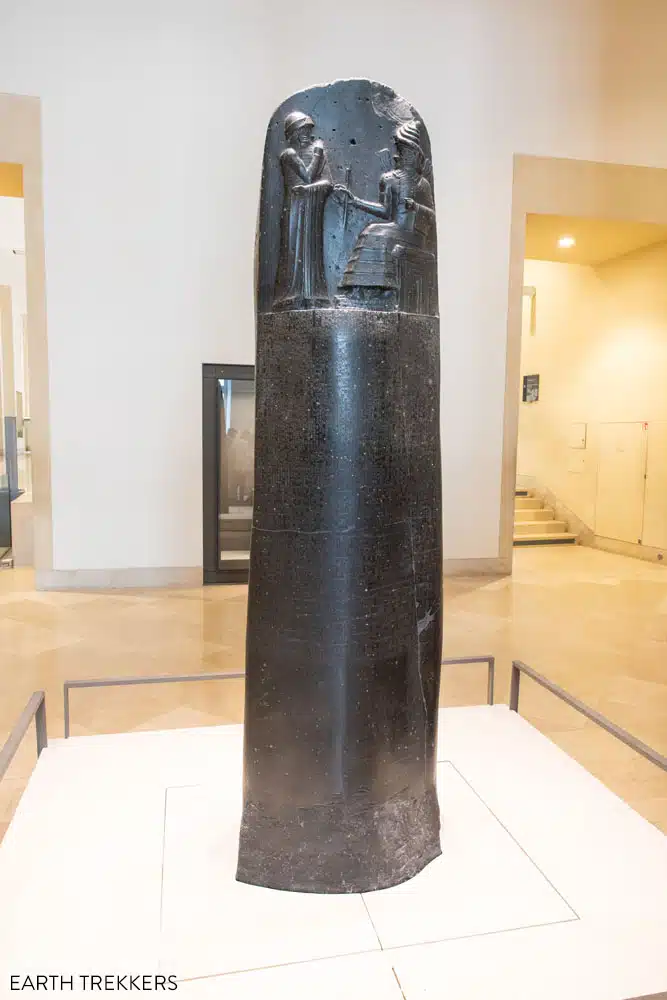
Code of Hammurabi
Exiting the Louvre
Our tour ends with the Code of Hammurabi. However, we have instructions on how to exit the Louvre, since this massive building is a confusing maze of rooms.
Walk back to the escalators and go down one level to -1. Make a U-turn at the bottom of the escalators and down some steps. Continue straight and turn left following the sortie signs.
You are now back in the main reception hall, under the Pyramid. There are exit signs directing you out of the Louvre. You will walk down a long hallway and you will see a restaurant, cafe, and boutique shops. This hallway ends at the inverted pyramid, in Galerie du Carrousel.
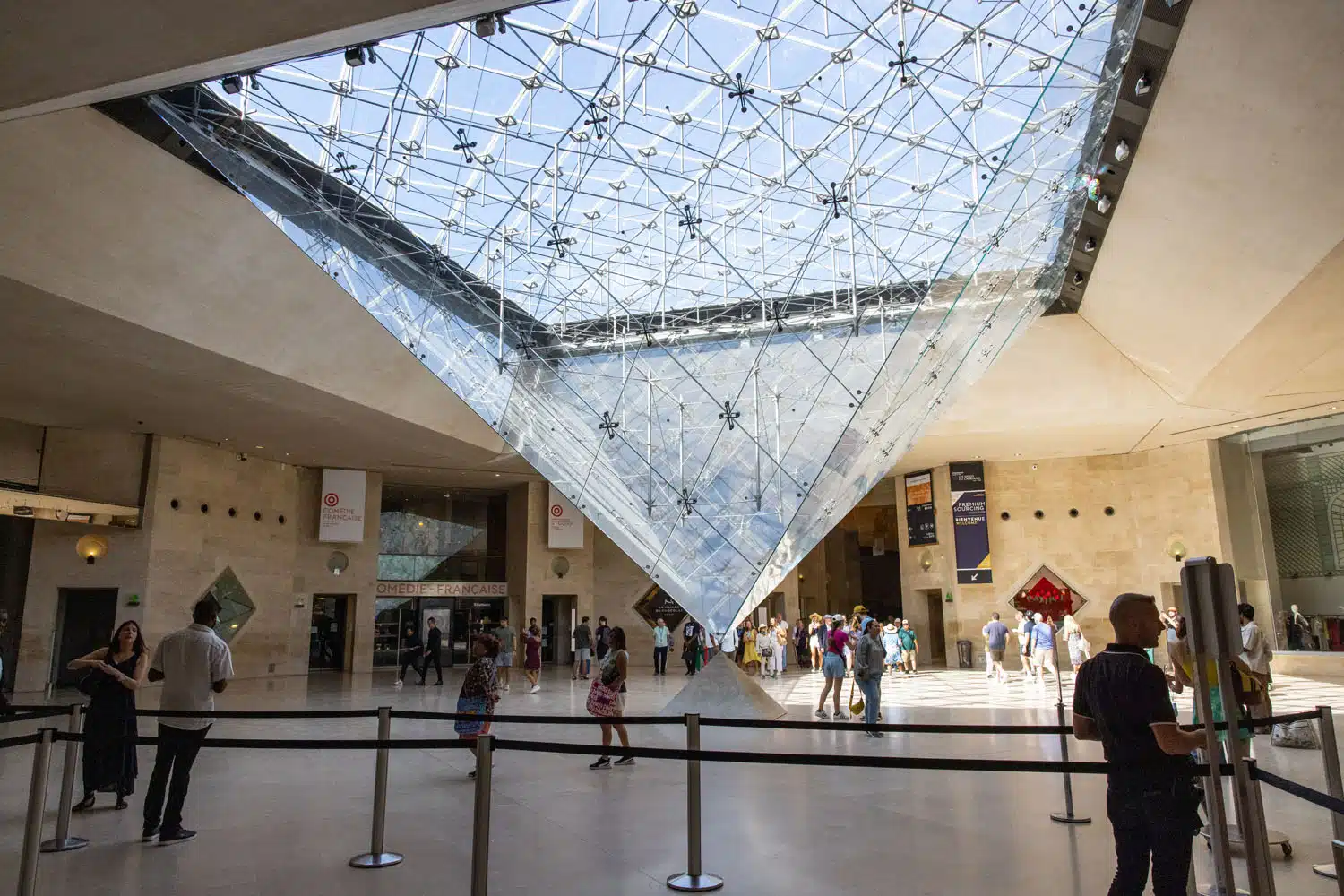
From this point, you can follow the metro signs to get on the metro at the Palais Royal – Musee du Louvre station or walk up the steps to Rue de Rivoli or Jardin du Carrousel.
I hope you enjoyed our walking tour of the Louvre and if you have any comments or suggestions for future readers, please let us know in the comment section below.
Get a Digital Download of this Louvre Walking Tour
Do you want a printer friendly version of this walking tour? How about an eBook version that can be downloaded onto your computer or mobile device?
Our Louvre Walking Tour eBook is a self-guided walking tour of the Louvre that will take you to the museum’s most important masterpieces. This guide covers how to purchase tickets, the different entrances, helps you navigate through the Louvre’s maze of rooms, and provides helpful tips for having the best experience. It is a 15-page document that you can download to take with you or print at home.
Click here to purchase the eBook on Etsy.com.

Frequently Asked Questions
How much time does it take to visit the Louvre?
If you are a speed demon, it’s possible to visit a few works of art in 30 to 45 minutes. However, the Louvre is filled with treasures from around the world, not just paintings and sculptures but also artifacts from ancient Egypt, Greece, and the Near East. For those who want to see the Louvre’s famous artworks and some of these ancient artifacts, plan on spending 3 to 5 hours in the Louvre.
Is the Louvre worth it?
Absolutely. The Louvre contains some of the most famous art pieces in the world, as well as ancient treasures from Greece, Egypt, and Mesopotamia. Plus, the building itself is an attraction, as this was once the palace for French kings before it became a museum.
What are the best things to see in the Louvre?
The three most famous artworks are the Mona Lisa, Venus de Milo, and the Winged Victory of Samothrace. Other notable works of art include the Rebellious Slave and the Dying Slave by Michelangelo, the Great Sphinx of Tanis and Psyche Revived by Cupid’s Kiss as well as ancient artifacts such as the Code of Hammurabi and the Lammasus of Khorsabad Palace.
Do you need to take a tour of the Louvre?
You do not need to take a tour of the Louvre. The cheapest way to visit the Louvre is to purchase your ticket online in advance on the official website and tour the Louvre independently. We have a free walking tour that takes you to the highlights. There is also an audio guide available for rent at the Louvre. However, there are many tours offered of the Louvre, if you prefer to visit the Louvre with an experienced guide.
Tours of the Louvre
If you still prefer to take a tour of the Louvre with an experience guide, here are several highly rated tours.
Louvre Tours & Tickets
If you have any questions about how to visit the Louvre or our walking tour of the Louvre, let us know in the comment section below.
More Information for Your Trip to France
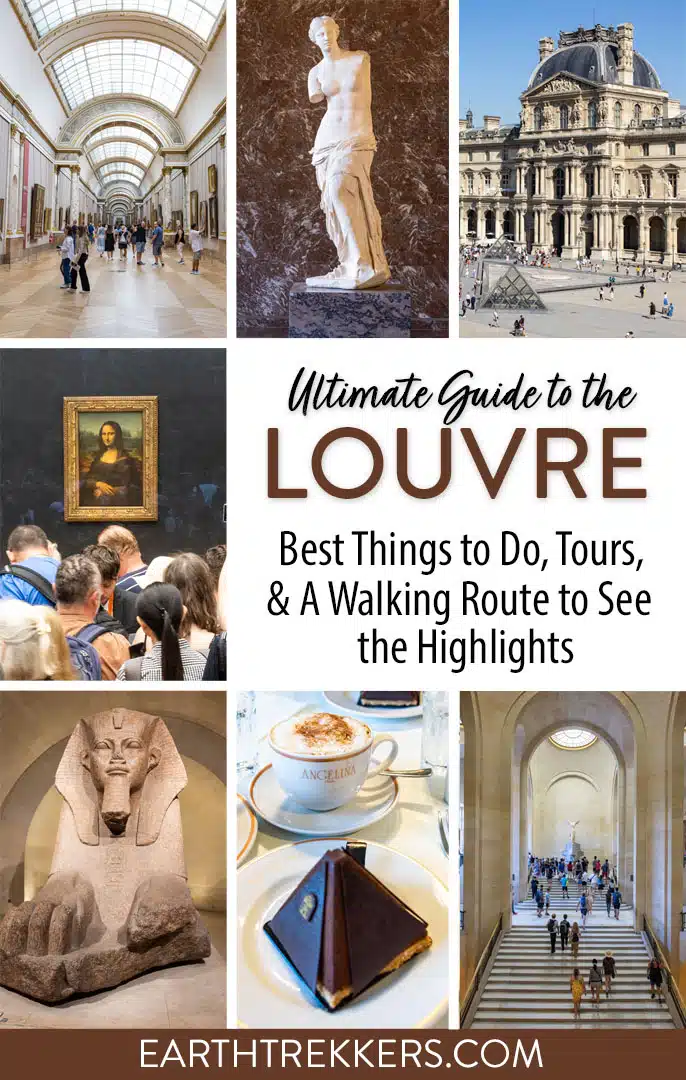
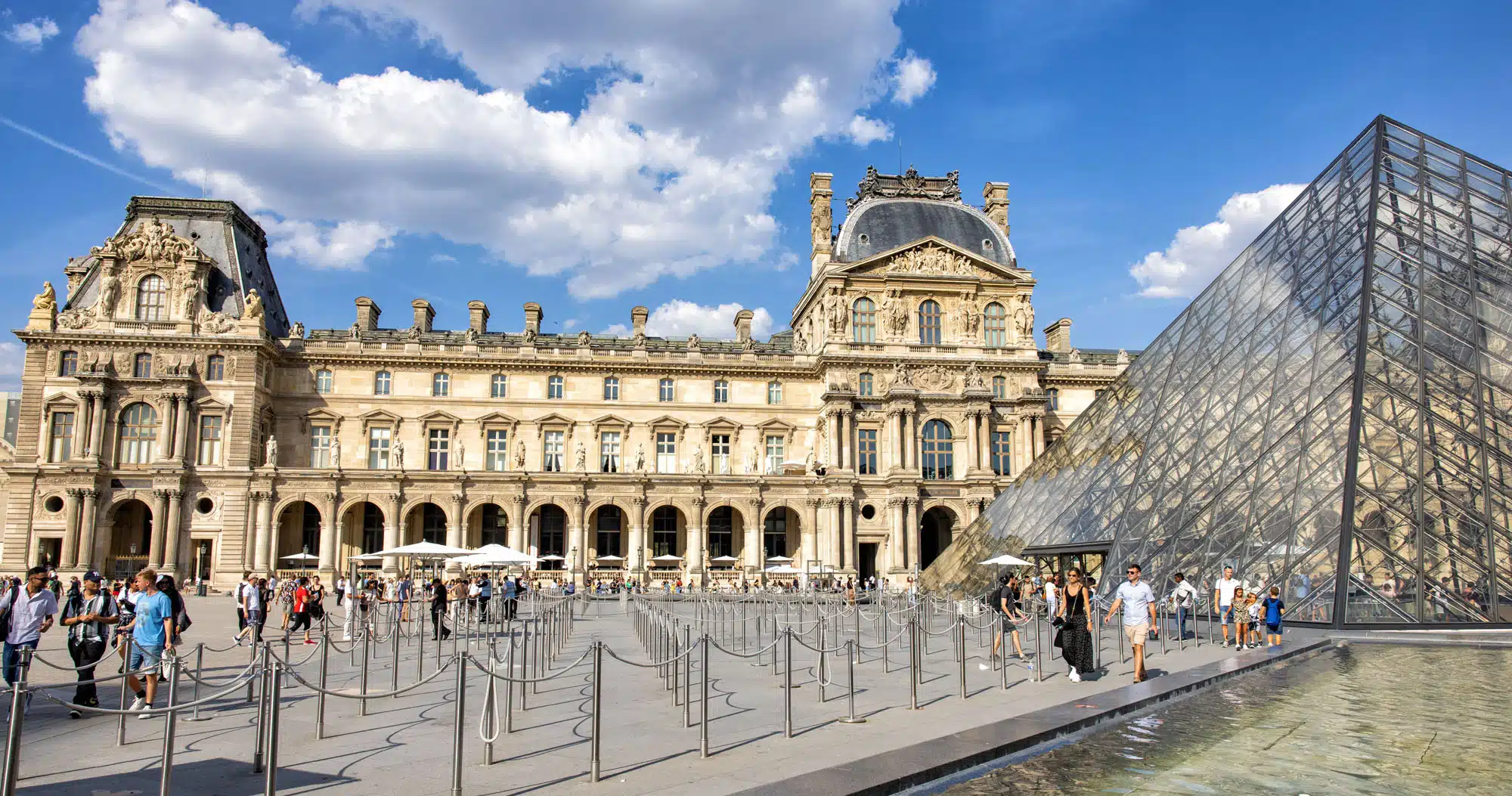
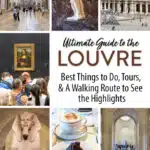
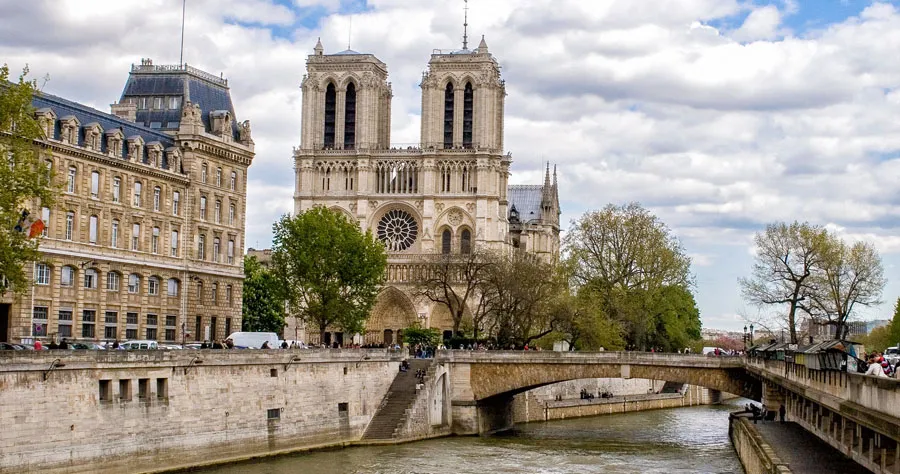
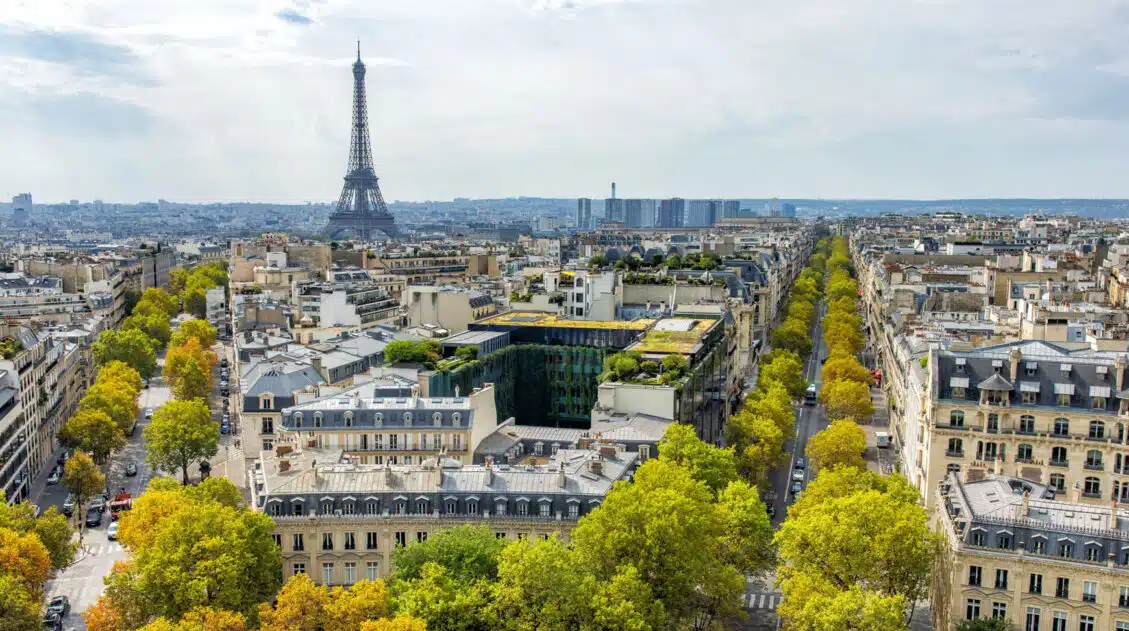

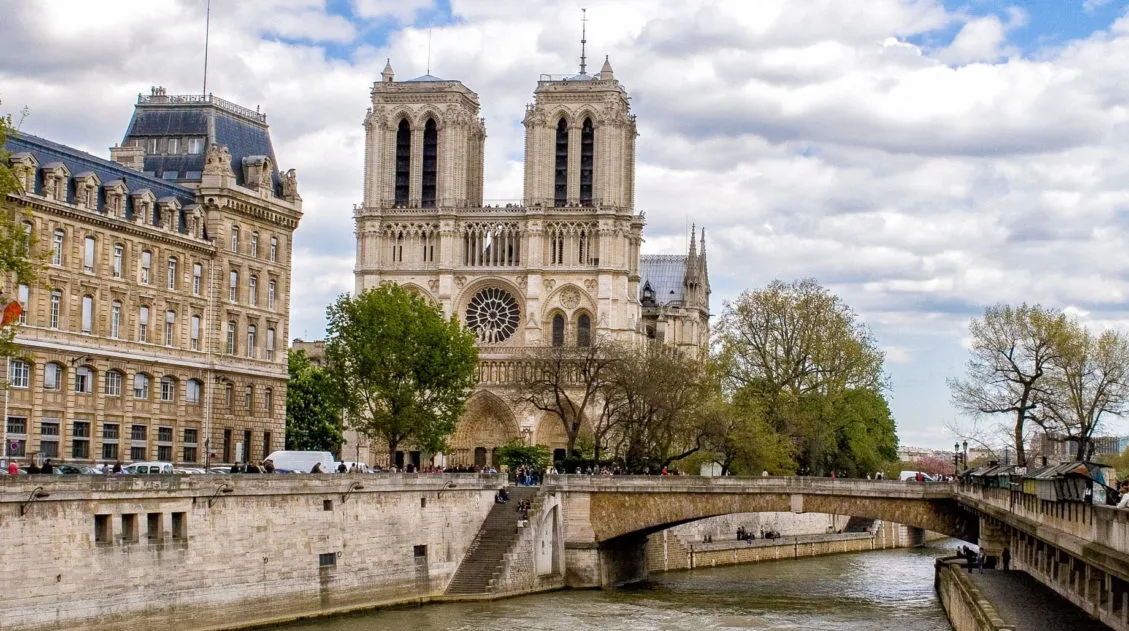
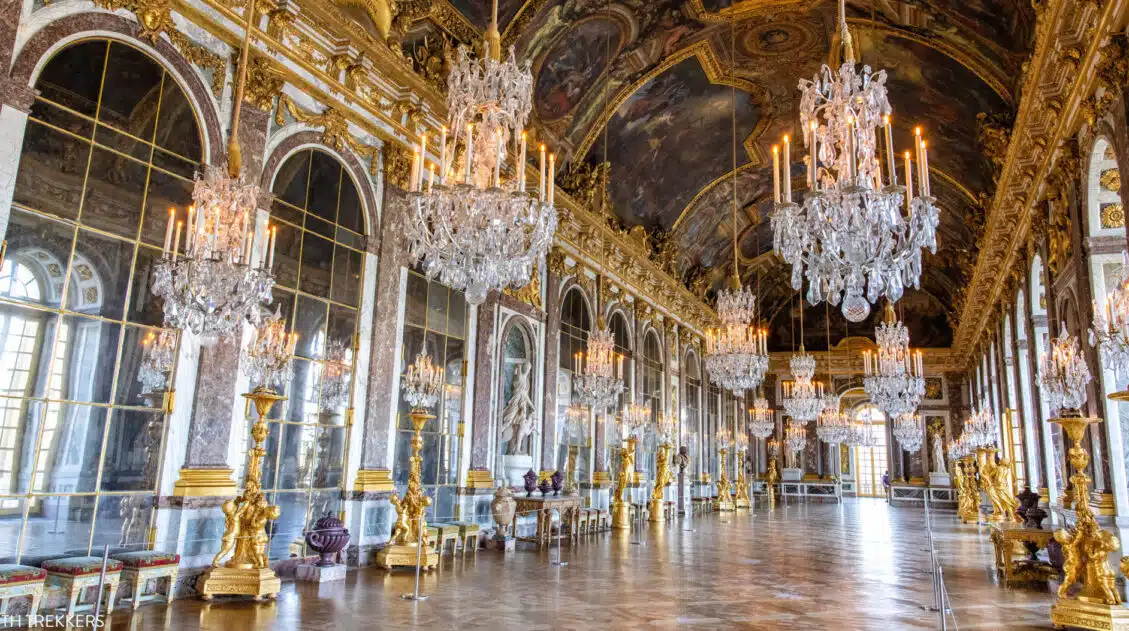

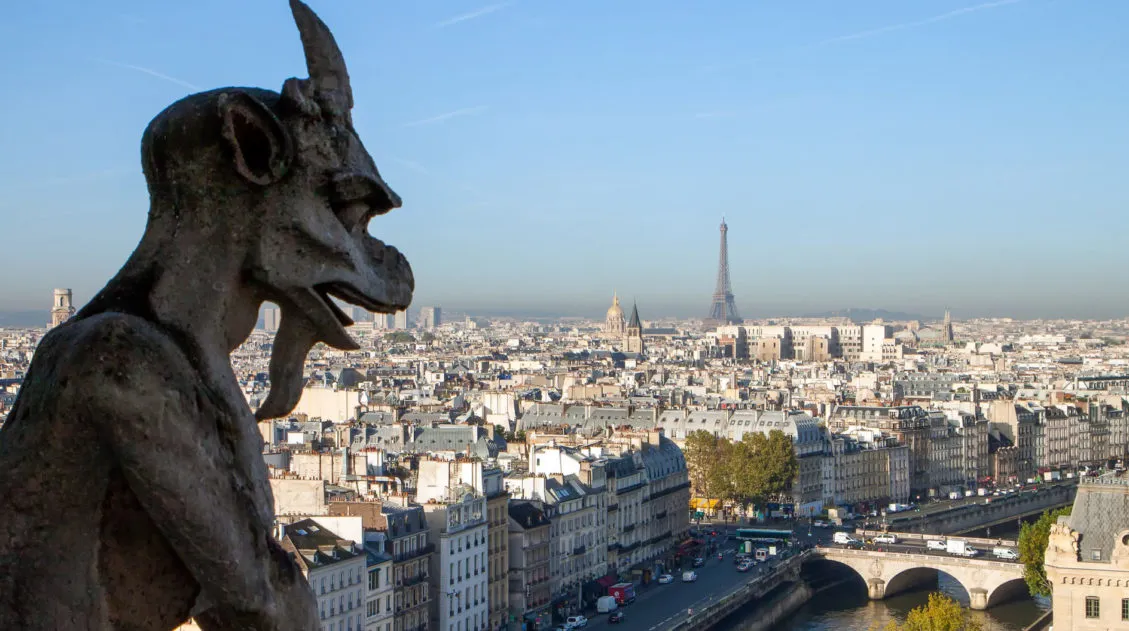
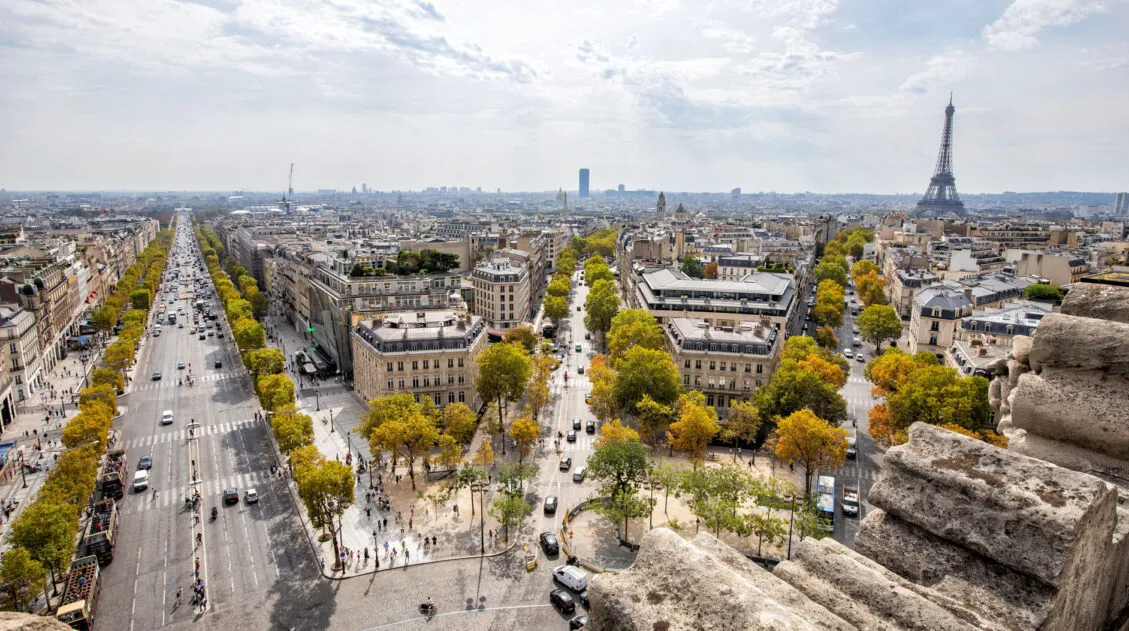
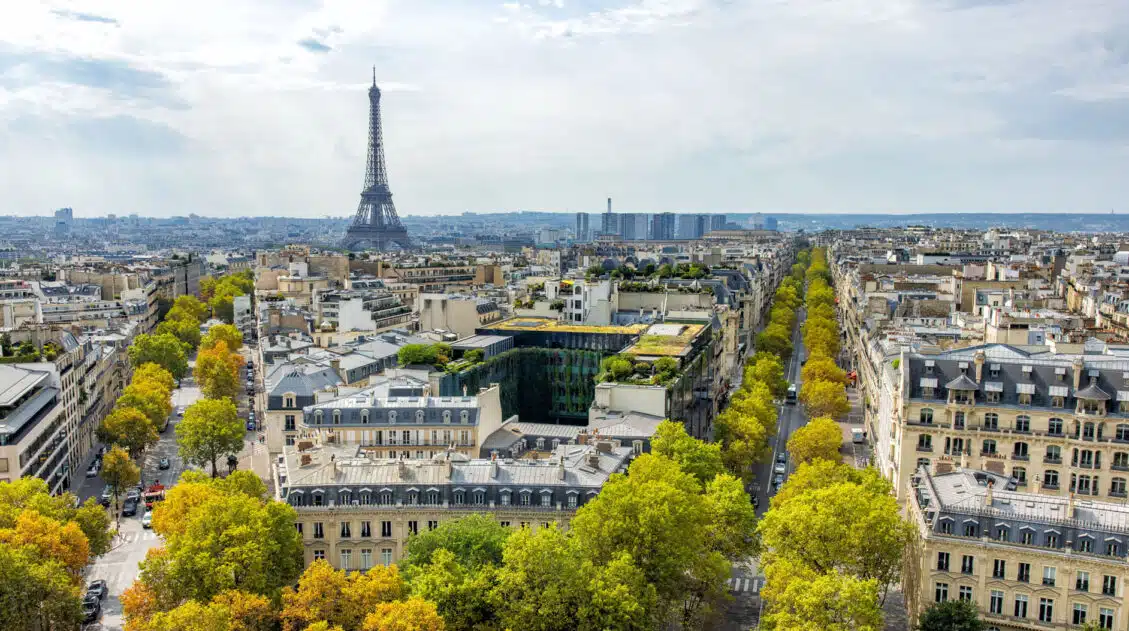

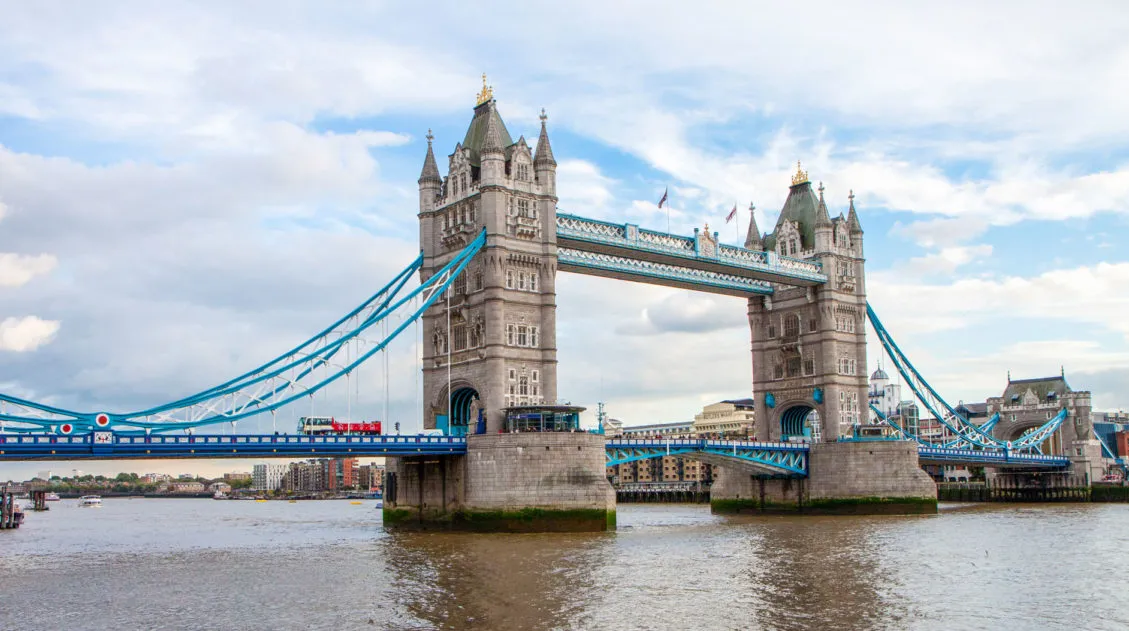
Comments 20